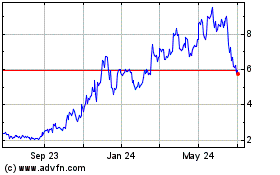false 0001783328 0001783328 2023-12-09 2023-12-09
UNITED STATES
SECURITIES AND EXCHANGE COMMISSION
Washington, D.C. 20549
FORM 8-K
CURRENT REPORT
Pursuant to Section 13 or 15(d)
of the Securities Exchange Act of 1934
Date of Report (Date of earliest event reported) December 9, 2023
TSCAN THERAPEUTICS, INC.
(Exact name of registrant as specified in its charter)
|
|
|
|
|
| Delaware |
|
001-40603 |
|
82-5282075 |
| (State or other jurisdiction of incorporation) |
|
(Commission File Number) |
|
(I.R.S. Employer Identification No.) |
|
|
|
| 830 Winter Street Waltham, Massachusetts |
|
02451 |
| (Address of principal executive offices) |
|
(Zip Code) |
Registrant’s telephone number, including area code (857) 399-9500
Not Applicable
(Former name or former address, if changed since last report)
Check the appropriate box below if the Form 8-K filing is intended to simultaneously satisfy the filing obligation of the registrant under any of the following provisions:
| ☐ |
Written communications pursuant to Rule 425 under the Securities Act (17 CFR 230.425) |
| ☐ |
Soliciting material pursuant to Rule 14a-12 under the Exchange Act (17 CFR 240.14a-12) |
| ☐ |
Pre-commencement communications pursuant to Rule 14d-2(b) under the Exchange Act (17 CFR 240.14d-2(b)) |
| ☐ |
Pre-commencement communications pursuant to Rule 13e-4(c) under the Exchange Act (17 CFR 240.13e-4(c)) |
Securities registered pursuant to Section 12(b) of the Act:
|
|
|
|
|
| Title of each class |
|
Trade Symbol(s) |
|
Name of each exchange on which registered |
| Voting Common Stock, $0.0001 par value per share |
|
TCRX |
|
The Nasdaq Global Market LLC |
Indicate by check mark whether the registrant is an emerging growth company as defined in Rule 405 of the Securities Act of 1933 (§ 230.405 of this chapter) or Rule 12b-2 of the Securities Exchange Act of 1934 (§ 240.12b-2 of this chapter).
Emerging growth company ☒
If an emerging growth company, indicate by check mark if the registrant has elected not to use the extended transition period for complying with any new or revised financial accounting standards provided pursuant to Section 13(a) of the Exchange Act. ☐
| Item 7.01 |
Regulation FD Disclosure. |
On December 9, 2023, TScan Therapeutics, Inc. (the “Company”) issued a press release announcing a poster presentation highlighting initial results from its ongoing Phase 1 multi-arm clinical trial evaluating TSC-100 and TSC-101 at the 65th American Society of Hematology (“ASH”) Annual Meeting and Exposition. The Company will host a virtual KOL event on Monday, December 11, 2023, at 8:00 a.m. ET to discuss the data presented at ASH. An archived webcast will be available following the call for 30 days on the Events & Presentations section of the Company’s website. A copy of the press release and the presentation materials for the KOL event are attached as Exhibits 99.1 and 99.2 to this Current Report on Form 8-K. The presentation materials for the KOL event will also be available in the investor relations section of the Company’s website at https://ir.tscan.com. Information contained on the Company’s website is not incorporated by reference into this Current Report on Form 8-K, and you should not consider any information on, or that can be accessed from, the Company’s website as part of this Current Report on Form 8-K.
The information under this Item 7.01, including Exhibits 99.1 and 99.2 hereto, is being furnished and shall not be deemed “filed” for purposes of Section 18 of the Securities Exchange Act of 1934, as amended (the “Exchange Act”), or otherwise subject to the liabilities of that section, nor shall it be deemed incorporated by reference in any filing under the Securities Act of 1933, as amended, or the Exchange Act, except as expressly set forth by specific reference in such a filing. The Company undertakes no obligation to update, supplement or amend the material attached hereto as Exhibits 99.1 and 99.2.
On December 9, 2023, the Company reported initial results from its ongoing Phase 1 multi-arm clinical trial evaluating TSC-100 and TSC-101.
The Phase 1 trial is a multi-arm dose escalation study evaluating TSC-100, TSC-101, or hematopoietic cell transplantation (“HCT”) alone in patients with acute myeloid leukemia (“AML”), acute lymphocytic leukemia (“ALL”) or myelodysplastic syndromes (“MDS”) undergoing haploidentical allogeneic HCT with reduced intensity conditioning. Patients enrolled in Dose Level 1 receive a single dose of either TSC-100 or TSC-101 approximately 21 days post-transplant. Patients enrolled in Dose Level 2 receive the same dose of TSC-100 or TSC-101 approximately 21 days post-transplant, followed by a second dose administered 40 days after the initial dose. For patients in Dose Level 3, the second dose is escalated four-fold. Primary endpoints include safety and dose-finding, and secondary and exploratory endpoints include relapse rates versus standard-of-care as well as qualitative biological readouts, including minimal residual disease (“MRD”) and donor chimerism. MRD specifically measures malignant cells to identify any residual disease present in a patient, and donor chimerism measures a combination of malignant, pre-malignant and normal cells, measuring any remaining patient-derived hematopoietic cells.
Higher sensitivity assays used to detect the activity of T cells:
| |
• |
|
Donor chimerism detected by high-sensitivity next-generation sequencing assay (AlloHeme) with limit of detection 0.13%. |
| |
• |
|
MRD detected by next-generation sequencing with limit of detection of 0.05-0.1%. |
Key Highlights from the Initial Results:
TSC-100 treatment arm (N=3 T-ALL, AML, AML)
| |
• |
|
3/3 evaluable patients treated with TSC-100 achieved complete donor chimerism and MRD negativity. |
TSC-101 treatment arm (N=3 TP53-mutated MDS, AML, B-ALL)
| |
• |
|
3/3 evaluable patients treated with TSC-101 achieved complete donor chimerism and MRD negativity, including a TP53-mutated MDS patient who remained with no detectable disease for over seven months post-HCT. |
| |
• |
|
One patient with AML was MRD-positive following HCT and converted to MRD-negative following treatment with TSC-101. |
Control arm (N=4, MDS, MDS, TP53-mutated MDS, AML) have been enrolled and received standard of care HCT alone:
| |
• |
|
One TP53-mutated MDS control-arm patient evolved with MRD positivity and worsening mixed chimerism, finally experiencing disease relapse approximately six months after transplantation. |
| |
• |
|
Two MDS control-arm patients developed worsening mixed chimerism that prompted early withdrawal of immunosuppression, which was complicated by grade 1 or grade 3 skin graft-vs-host disease. |
| |
• |
|
0/4 patients achieved and maintained complete donor chimerism. |
The type and severity of adverse events observed to date were comparable between TSC-100 and TSC-101 treatment arm patients and control arm patients.
| Item 9.01 |
Financial Statements and Exhibits. |
(d) Exhibits.
The following exhibits are filed as part of this report:
SIGNATURE
Pursuant to the requirements of the Securities Exchange Act of 1934, as amended, the registrant has duly caused this report to be signed on its behalf by the undersigned hereunto duly authorized.
|
|
|
|
|
|
|
|
|
|
|
TScan Therapeutics, Inc. |
|
|
|
|
| Date: December 11, 2023 |
|
|
|
By: |
|
/s/ Gavin MacBeath |
|
|
|
|
|
|
Gavin MacBeath |
|
|
|
|
|
|
Chief Executive Officer |
Exhibit 99.1

TScan Therapeutics Presents Initial Phase 1 Clinical Results on
TSC-100 and TSC-101 at the 65th American Society of Hematology Annual Meeting and Exposition
No relapses have occurred in six of six treatment-arm patients, four with follow-up past six months; one of four control-arm patients relapsed at six months and two others required clinical intervention
No patient-derived hematopoietic cells detected in six of six treatment-arm patients, indicating
complete elimination of target cells, versus zero of four control-arm patients
AML patient
with detectable disease post-transplant converted to no detectable disease following treatment with TSC-101
Patients enrolled up to the third and final dose level in both treatment arms with no dose limiting toxicities
Company to host virtual KOL event on Monday, December 11, at 8:00 a.m. ET to discuss the data presented at the ASH Annual Meeting and
Exposition
WALTHAM, Mass., Dec. 9, 2023 — TScan Therapeutics, Inc. (Nasdaq: TCRX), a clinical-stage biopharmaceutical company focused on
the development of T cell receptor (TCR)-engineered T cell therapies (TCR-T) for the treatment of patients with cancer, today announced a poster presentation at the 65th American Society of Hematology (ASH) Annual Meeting and Exposition. The poster highlights initial data from the Phase 1 multi-arm clinical trial
evaluating TSC-100 and TSC-101, which are designed to treat residual disease and prevent relapse following hematopoietic cell transplantation (HCT) in patients with
acute myeloid leukemia (AML), myelodysplastic syndromes (MDS), or acute lymphocytic leukemia (ALL) (NCT05473910).
“We are excited to present initial
clinical data in our heme program, with six patients in our treatment arms and four patients in our control arm. Complete donor chimerism and MRD negativity, two favorable indicators of treatment success, were achieved and maintained in all six
treated patients, four of whom have been on the study for over six months. In contrast, these indicators were not achieved in any of the four control-arm patients. In addition, one of the control-arm patients relapsed at six months, and two other control-arm patients required clinical intervention due to worsening chimerism, a sign of potential future
relapse,” said Debora Barton, M.D., Chief Medical Officer. “We have now enrolled and dosed patients up to the third and final dose level with no DLTs observed to date and no safety signals thus far, indicating that the third dose level
will likely be the recommended Phase 2 dose. After establishing the recommended Phase 2 dose, we plan to open expansion cohorts at that dose to further characterize safety and evaluate translational and efficacy endpoints. There are currently
10 active clinical sites, and additional sites are in the process of being activated to participate in these expansion cohorts.”
“Hematopoietic
cell transplantation is currently the best treatment option for many patients suffering from AML, MDS, and ALL, as approximately 60% of patients are cured by this procedure,” said Gavin MacBeath, Ph.D., Chief Executive Officer.
“Unfortunately, for patients who relapse following transplantation, the prognosis is very poor. We have designed TSC-100 and TSC-101 to address this unmet need and
increase the success rate of transplantation. We are very encouraged by these early data as they indicate that our therapies are working as designed. The translational data show that our cell therapies are eliminating all residual patient-derived
malignant, pre-malignant, and benign cells, which are the cells that drive relapse. We are grateful to all the patients and their families who are participating in this trial and look forward to sharing more
data in 2024 as the study continues to enroll.”
The Phase 1 trial is a multi-arm dose escalation study evaluating TSC-100, TSC-101, or HCT alone in patients with AML, ALL or MDS undergoing haploidentical allogeneic HCT with reduced intensity conditioning. Patients enrolled in Dose
Level 1 receive a single dose of either TSC-100 or TSC-101 approximately 21 days post-transplant. Patients enrolled in Dose Level 2 receive the same dose of TSC-100 or TSC-101 approximately 21 days post-transplant, followed by a second dose administered 40 days after the initial dose. For patients in Dose Level 3, the second
dose is escalated four-fold. Primary endpoints include safety and dose-finding, and secondary and exploratory endpoints include relapse rates versus standard-of-care as
well as qualitative biological readouts, including MRD and donor chimerism. MRD specifically measures malignant cells, to identify any residual disease present in a patient, and donor chimerism measures a combination of malignant, pre-malignant and normal cells, measuring any remaining patient-derived hematopoietic cells.
Key Poster Highlights:
TSC-100 treatment arm (N=3 T-ALL, AML, AML)
| |
• |
|
3/3 patients treated with TSC-100 achieved complete donor chimerism and
MRD negativity. |
TSC-101 treatment arm (N=3 TP53 mutated MDS, AML, B-ALL)
| |
• |
|
3/3 patients treated with TSC-101 achieved complete donor chimerism and
MRD negativity, including a TP53-mutated MDS patient who remained with no detectable disease for over seven months post-HCT. |
| |
• |
|
One patient with AML was MRD-positive following HCT and converted to MRD-negative following treatment with TSC-101. |
Four control
arm patients (MDS, MDS, TP53-mutated MDS, AML) have been enrolled and received standard of care HCT alone:
| |
• |
|
One TP53-mutated MDS control-arm patient evolved with MRD positivity and
worsening mixed chimerism, finally experiencing disease relapse approximately six months after transplantation. |
| |
• |
|
Two MDS control-arm patients developed worsening mixed chimerism that
prompted early withdrawal of immunosuppression, which was complicated by grade 1 or grade 3 skin graft-vs-host disease. |
| |
• |
|
0/4 of the control-arm patients achieved and maintained complete donor
chimerism. |
Higher sensitivity assays used to detect the activity of T cells:
| |
• |
|
Donor chimerism detected by high-sensitivity next-generation sequencing assay (AlloHeme) with limit of detection
0.13%. |
| |
• |
|
MRD detected by next-generation sequencing with limit of detection of
0.05-0.1%. |
A copy of the poster can be accessed on the “Publications” section of the
Company’s website at www.tscan.com.
Virtual KOL Event
The Company will host a virtual KOL event featuring Monzr M. Al Malki, M.D., on Monday, December 11, 2023, at 8:00 a.m. ET to discuss the data presented
at ASH. Dr. Al Malki is an Associate Professor in the Department of Hematology & Hematopoietic Cell Transplantation and Director of the Unrelated Donor Bone Marrow Transplant and Haploidentical Transplant Programs at City of Hope.
Details for attending the live event can be found here.
About TScan Therapeutics, Inc.
TScan is a clinical-stage biopharmaceutical company focused on the development of T cell receptor (TCR)-engineered T cell therapies (TCR-T) for the treatment of patients with cancer. The Company’s lead TCR-T therapy candidates, TSC-100 and TSC-101, are in development for the treatment of patients with hematologic malignancies to eliminate residual disease and prevent relapse after allogeneic hematopoietic cell transplantation. The Company is also
developing multiplexed TCR-T therapy candidates for the treatment of various solid tumors. The Company has developed and continues to build its ImmunoBank, the Company’s repository of therapeutic TCRs
that recognize diverse targets and are associated with multiple HLA types, to provide customized multiplexed TCR-T therapies for patients with a variety of solid tumors.
Forward-Looking Statements
This release contains
forward-looking statements within the meaning of the Private Securities Litigation Reform Act of 1995, including, but not limited to, express or implied statements regarding the Company’s plans, progress, and timing relating to the
Company’s hematologic malignancies program; the Company’s current and future research and development plans or expectations; the structure, timing and success of the Company’s planned preclinical development, submission of INDs, and
clinical trials; the potential benefits of any of the Company’s proprietary platforms, multiplexing, or current or future product candidates in treating patients; the Company’s beliefs about operating expenses and that it will have capital
to fund the Company into 2026; and the Company’s goals and strategy. TScan intends such forward-looking statements to be covered by the safe harbor provisions for forward-looking statements contained in Section 21E of the Securities
Exchange Act of 1934 and the Private Securities Litigation Reform Act of 1995. In some cases, you can identify forward-looking statements by terms such as, but not limited to, “may,” “might,” “will,”
“objective,” “intend,” “should,” “could,” “can,” “would,” “expect,” “believe,” “anticipate,” “project,” “target,” “design,”
“estimate,” “predict,” “potential,” “plan,” “on track,” or similar expressions or the negative of those terms. Such forward-looking statements are based upon current expectations that involve risks,
changes in circumstances, assumptions, and uncertainties. The express or implied forward-looking statements included in this release are only predictions and are subject to a number of risks, uncertainties and assumptions, including, without
limitation: the beneficial characteristics, safety, efficacy, therapeutic effects and potential advantages of TScan’s TCR-T therapy candidates; TScan’s expectations regarding its preclinical studies
being predictive of clinical trial results; the timing of the initiation, progress and expected results of TScan’s preclinical studies, clinical trials and its research and development programs; TScan’s plans relating to developing and
commercializing its TCR-T therapy candidates, if approved, including sales strategy; estimates of the size of the addressable market for TScan’s TCR-T therapy
candidates; TScan’s manufacturing capabilities and the scalable nature of its manufacturing process; TScan’s estimates regarding expenses, future milestone payments and revenue, capital requirements and needs for additional
financing; TScan’s expectations regarding competition; TScan’s anticipated growth strategies; TScan’s ability to attract or retain key personnel; TScan’s ability to establish
and maintain development partnerships and collaborations; TScan’s expectations regarding federal, state and foreign regulatory requirements; TScan’s ability to obtain and maintain intellectual property protection for its proprietary
platform technology and our product candidates; the sufficiency of TScan’s existing capital resources to fund its future operating expenses and capital expenditure requirements and execute on upcoming anticipated milestones into 2026; and the
effect of the COVID-19 pandemic, including mitigation efforts and political, economic, legal and social effects, on any of the foregoing or other aspects of TScan’s business or operations; and other
factors that are described in the “Risk Factors” and “Management’s Discussion and Analysis of Financial Condition and Results of Operations” sections of TScan’s most recent Annual Report on Form 10-K and any other filings that TScan has made or may make with the SEC in the future. Any forward-looking statements contained in this release represent TScan’s views only as of the date hereof
and should not be relied upon as representing its views as of any subsequent date. Except as required by law, TScan explicitly disclaims any obligation to update any forward-looking statements.
Contacts
Heather Savelle
TScan Therapeutics, Inc.
VP, Investor Relations
857-399-9840
hsavelle@tscan.com
Joyce Allaire
LifeSci Advisors, LLC
Managing Director
617-435-6602
jallaire@lifesciadvisors.com
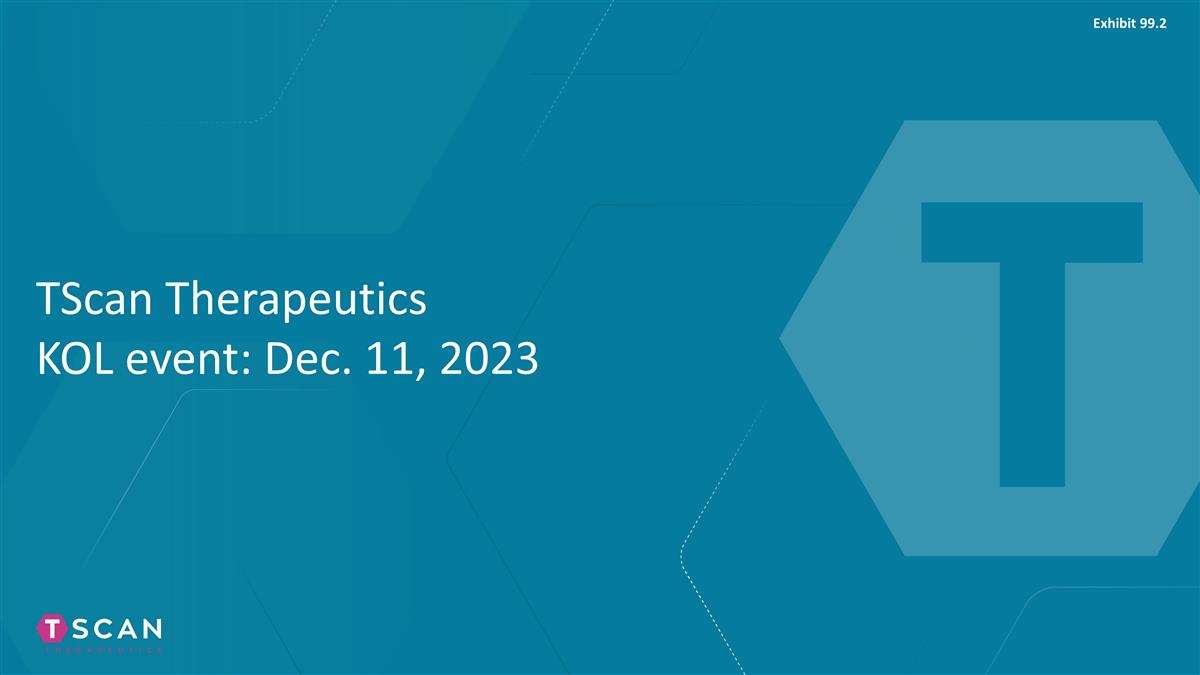
TScan Therapeutics KOL event: Dec. 11,
2023 Exhibit 99.2
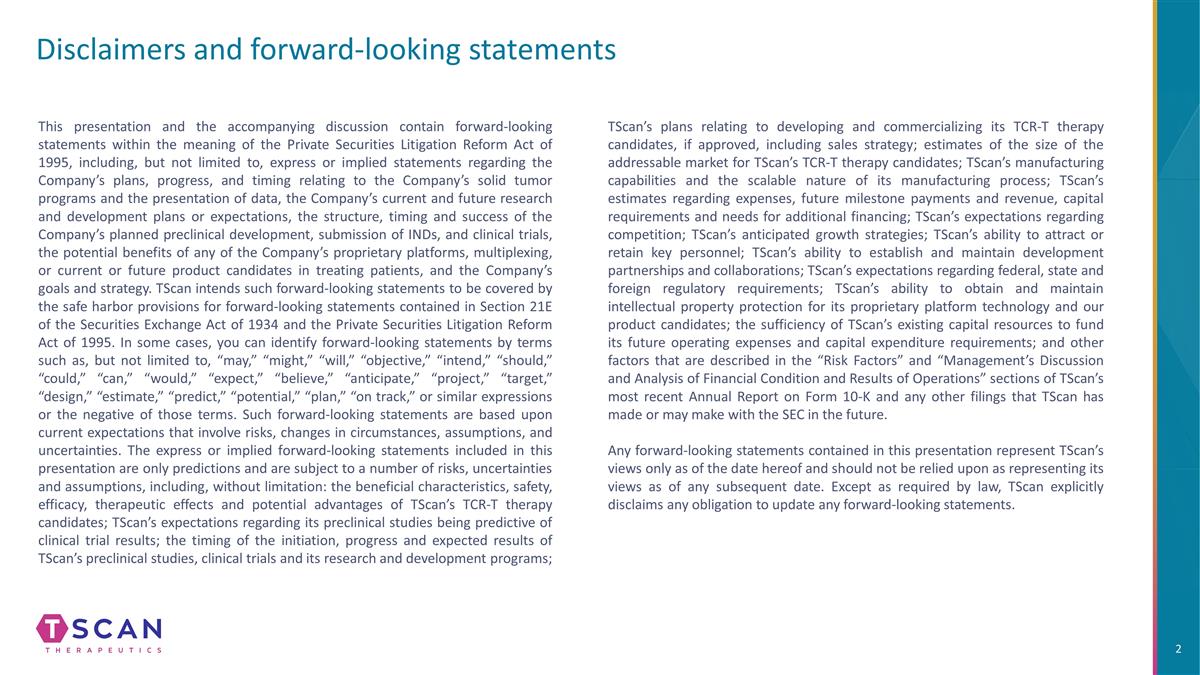
Disclaimers and forward-looking
statements This presentation and the accompanying discussion contain forward-looking statements within the meaning of the Private Securities Litigation Reform Act of 1995, including, but not limited to, express or implied statements regarding the
Company’s plans, progress, and timing relating to the Company’s solid tumor programs and the presentation of data, the Company’s current and future research and development plans or expectations, the structure, timing and success
of the Company’s planned preclinical development, submission of INDs, and clinical trials, the potential benefits of any of the Company’s proprietary platforms, multiplexing, or current or future product candidates in treating patients,
and the Company’s goals and strategy. TScan intends such forward-looking statements to be covered by the safe harbor provisions for forward-looking statements contained in Section 21E of the Securities Exchange Act of 1934 and the Private
Securities Litigation Reform Act of 1995. In some cases, you can identify forward-looking statements by terms such as, but not limited to, “may,” “might,” “will,” “objective,” “intend,”
“should,” “could,” “can,” “would,” “expect,” “believe,” “anticipate,” “project,” “target,” “design,” “estimate,”
“predict,” “potential,” “plan,” “on track,” or similar expressions or the negative of those terms. Such forward-looking statements are based upon current expectations that involve risks, changes in
circumstances, assumptions, and uncertainties. The express or implied forward-looking statements included in this presentation are only predictions and are subject to a number of risks, uncertainties and assumptions, including, without limitation:
the beneficial characteristics, safety, efficacy, therapeutic effects and potential advantages of TScan’s TCR-T therapy candidates; TScan’s expectations regarding its preclinical studies being predictive of clinical trial results; the
timing of the initiation, progress and expected results of TScan’s preclinical studies, clinical trials and its research and development programs; TScan’s plans relating to developing and commercializing its TCR-T therapy candidates, if
approved, including sales strategy; estimates of the size of the addressable market for TScan’s TCR-T therapy candidates; TScan’s manufacturing capabilities and the scalable nature of its manufacturing process; TScan’s estimates
regarding expenses, future milestone payments and revenue, capital requirements and needs for additional financing; TScan’s expectations regarding competition; TScan’s anticipated growth strategies; TScan’s ability to attract or
retain key personnel; TScan’s ability to establish and maintain development partnerships and collaborations; TScan’s expectations regarding federal, state and foreign regulatory requirements; TScan’s ability to obtain and maintain
intellectual property protection for its proprietary platform technology and our product candidates; the sufficiency of TScan’s existing capital resources to fund its future operating expenses and capital expenditure requirements; and other
factors that are described in the “Risk Factors” and “Management’s Discussion and Analysis of Financial Condition and Results of Operations” sections of TScan’s most recent Annual Report on Form 10-K and any other
filings that TScan has made or may make with the SEC in the future. Any forward-looking statements contained in this presentation represent TScan’s views only as of the date hereof and should not be relied upon as representing its views as of
any subsequent date. Except as required by law, TScan explicitly disclaims any obligation to update any forward-looking statements.
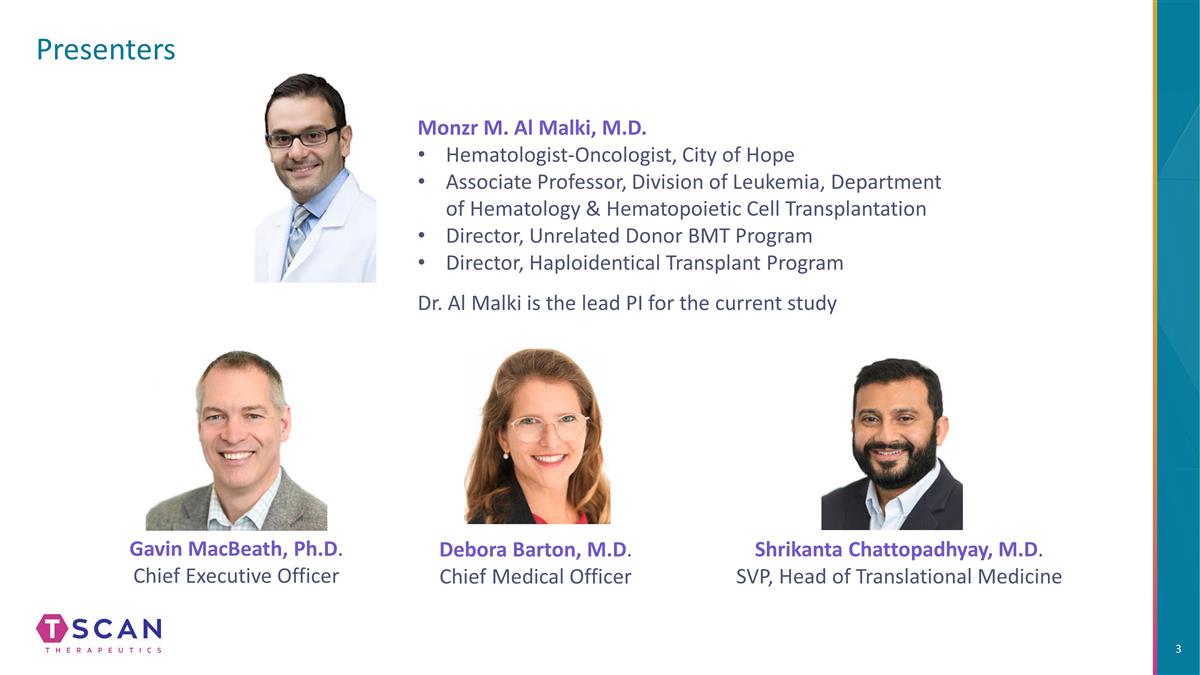
Presenters Monzr M. Al Malki, M.D.
Hematologist-Oncologist, City of Hope Associate Professor, Division of Leukemia, Department of Hematology & Hematopoietic Cell Transplantation Director, Unrelated Donor BMT Program Director, Haploidentical Transplant Program Gavin MacBeath,
Ph.D. Chief Executive Officer Debora Barton, M.D. Chief Medical Officer Shrikanta Chattopadhyay, M.D. SVP, Head of Translational Medicine Dr. Al Malki is the lead PI for the current study
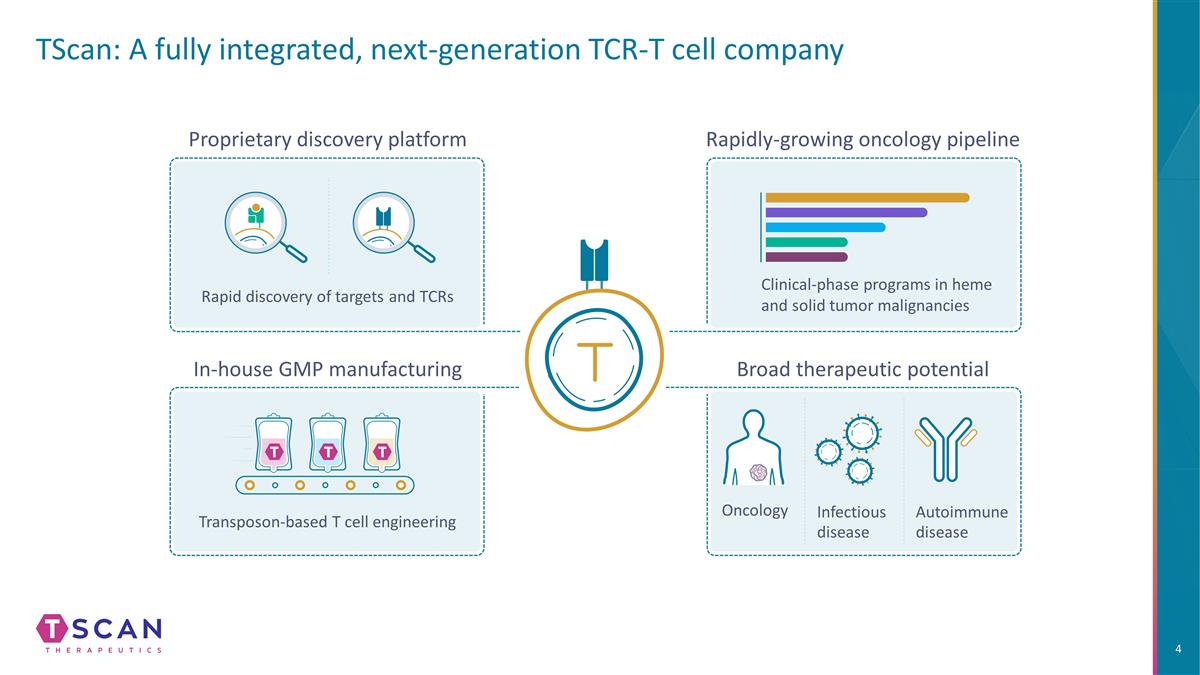
TScan: A fully integrated,
next-generation TCR-T cell company Rapid discovery of targets and TCRs Transposon-based T cell engineering Clinical-phase programs in heme and solid tumor malignancies Infectious disease Autoimmune disease Oncology Rapidly-growing oncology pipeline
Broad therapeutic potential Proprietary discovery platform In-house GMP manufacturing
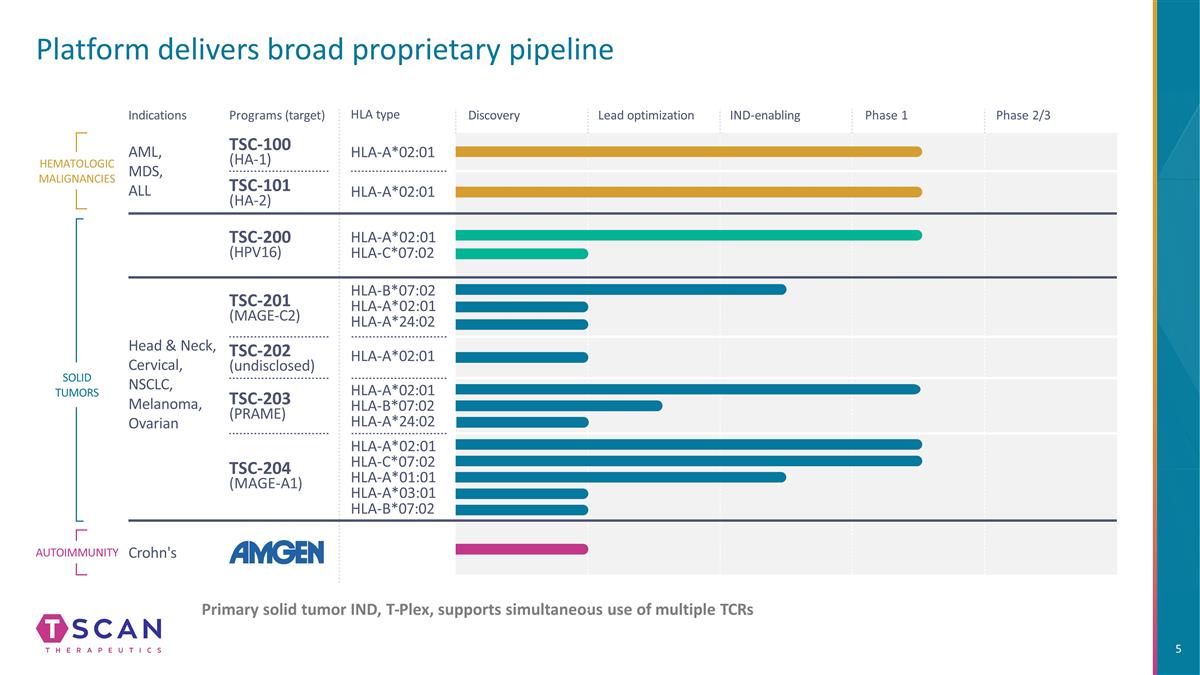
Platform delivers broad proprietary
pipeline Primary solid tumor IND, T-Plex, supports simultaneous use of multiple TCRs HLA type Indications Programs (target) TSC-100 (HA-1) HLA-A*02:01 HLA-A*02:01 HLA-A*02:01 HLA-C*07:02 HLA-B*07:02 HLA-A*02:01 HLA-A*24:02 HLA-A*02:01 HLA-C*07:02
HLA-A*01:01 HLA-A*03:01 HLA-B*07:02 HLA-A*02:01 HLA-B*07:02 HLA-A*24:02 TSC-101 (HA-2) TSC-200 (HPV16) TSC-201 (MAGE-C2) TSC-202 (undisclosed) TSC-203 (PRAME) TSC-204 (MAGE-A1) HEMATOLOGIC MALIGNANCIES SOLID TUMORS AML, MDS, ALL Head & Neck,
Cervical, NSCLC, Melanoma, Ovarian HLA-A*02:01 Autoimmunity Crohn's Discovery Lead optimization IND-enabling Phase 1 Phase 2/3
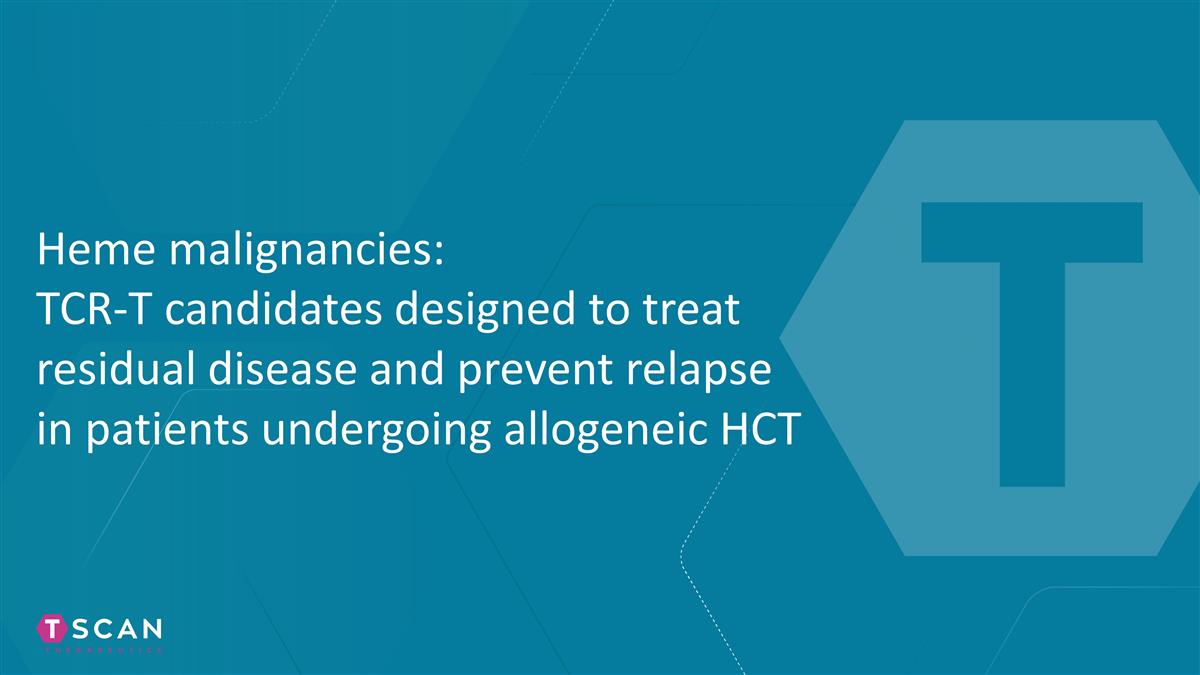
Heme malignancies: TCR-T candidates
designed to treat residual disease and prevent relapse in patients undergoing allogeneic HCT
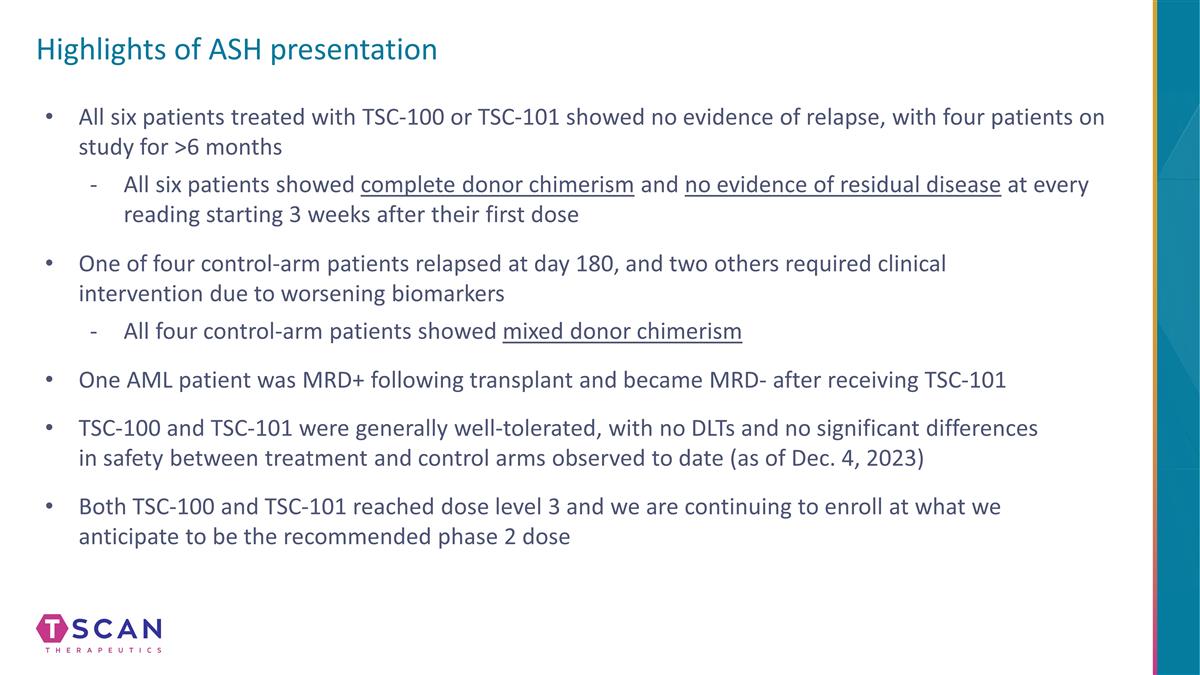
Highlights of ASH presentation All six
patients treated with TSC-100 or TSC-101 showed no evidence of relapse, with four patients on study for >6 months All six patients showed complete donor chimerism and no evidence of residual disease at every reading starting 3 weeks after their
first dose One of four control-arm patients relapsed at day 180, and two others required clinical intervention due to worsening biomarkers All four control-arm patients showed mixed donor chimerism Both TSC-100 and TSC-101 reached dose level 3 and
we are continuing to enroll at what we anticipate to be the recommended phase 2 dose TSC-100 and TSC-101 were generally well-tolerated, with no DLTs and no significant differences in safety between treatment and control arms observed to date (as of
Dec. 4, 2023) One AML patient was MRD+ following transplant and became MRD- after receiving TSC-101
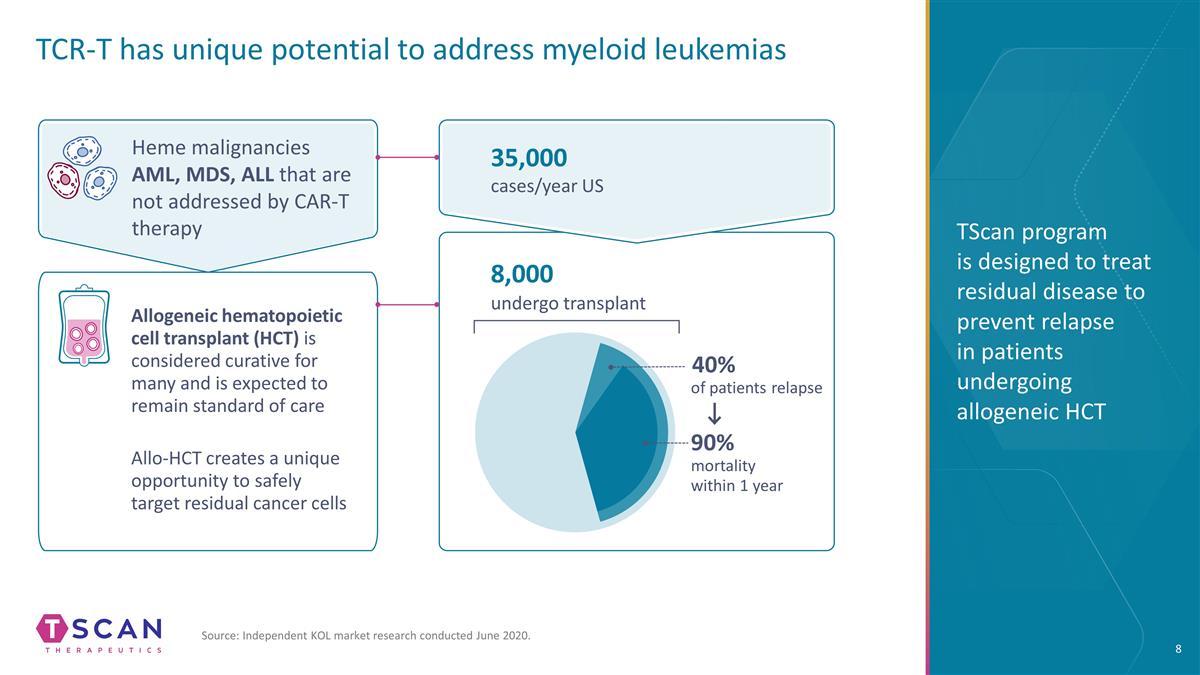
TCR-T has unique potential to address
myeloid leukemias Source: Independent KOL market research conducted June 2020. Heme malignancies AML, MDS, ALL that are not addressed by CAR-T therapy 35,000 cases/year US Allogeneic hematopoietic cell transplant (HCT) is considered curative for
many and is expected to remain standard of care Allo-HCT creates a unique opportunity to safely target residual cancer cells 90% mortality within 1 year 40% of patients relapse 8,000 undergo transplant TScan program is designed to treat residual
disease to prevent relapse in patients undergoing allogeneic HCT
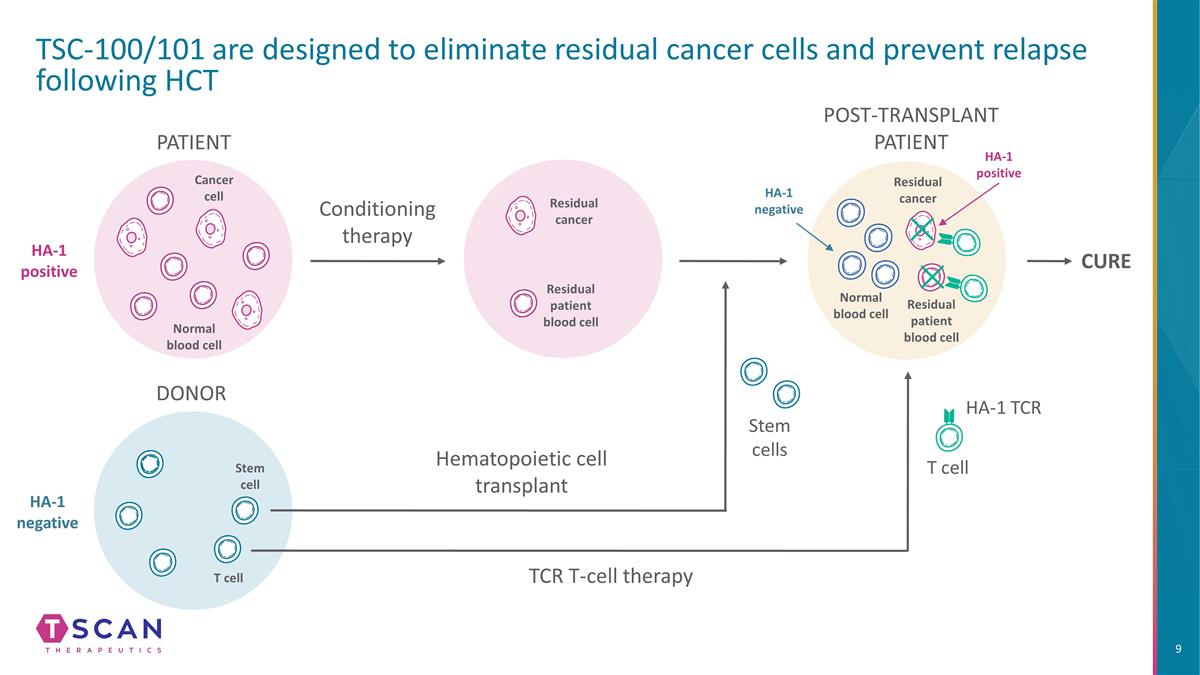
TSC-100/101 are designed to eliminate
residual cancer cells and prevent relapse following HCT Conditioning therapy PATIENT DONOR Hematopoietic cell transplant Stem cells CURE TCR T-cell therapy T cell HA-1 TCR Cancer cell Normal blood cell Stem cell T cell HA-1 positive HA-1 negative
Residual cancer HA-1 negative HA-1 positive Residual cancer Normal blood cell Residual patient blood cell Residual patient blood cell POST-TRANSPLANT PATIENT
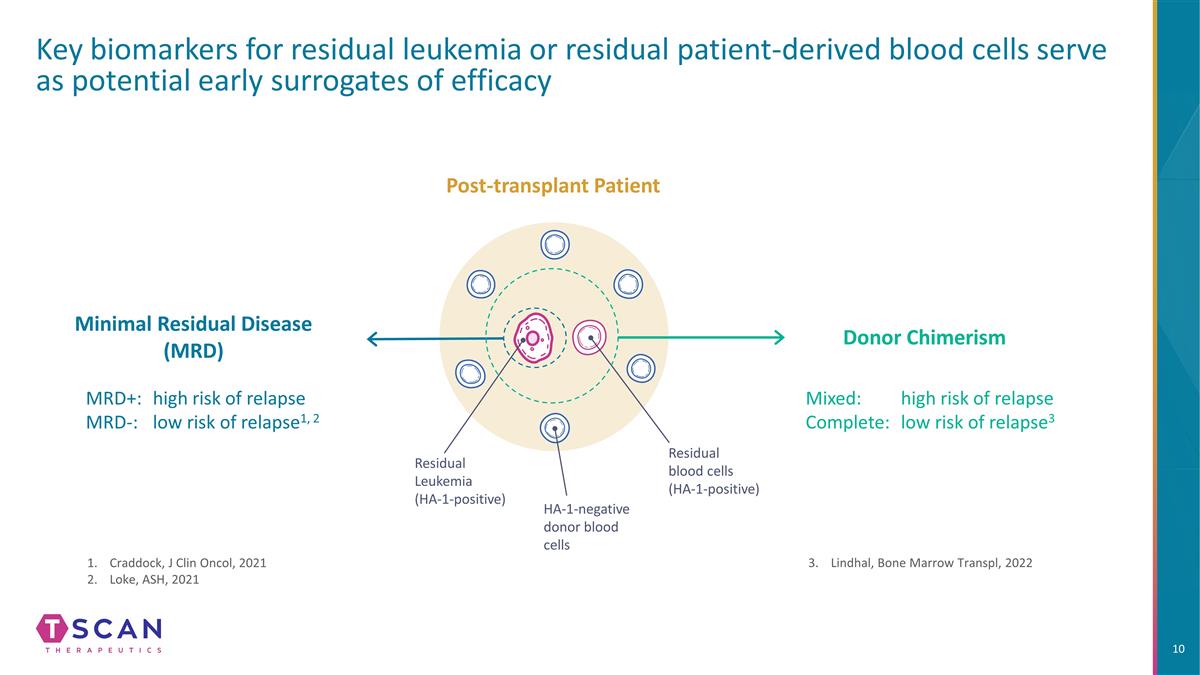
Key biomarkers for residual
leukemia or residual patient-derived blood cells serve as potential early surrogates of efficacy Residual Leukemia (HA-1-positive) Residual blood cells (HA-1-positive) HA-1-negative donor blood cells Post-transplant Patient Donor Chimerism Minimal
Residual Disease (MRD) MRD+:high risk of relapse MRD-:low risk of relapse1, 2 Lindhal, Bone Marrow Transpl, 2022 Craddock, J Clin Oncol, 2021 Loke, ASH, 2021 Mixed:high risk of relapse Complete:low risk of relapse3
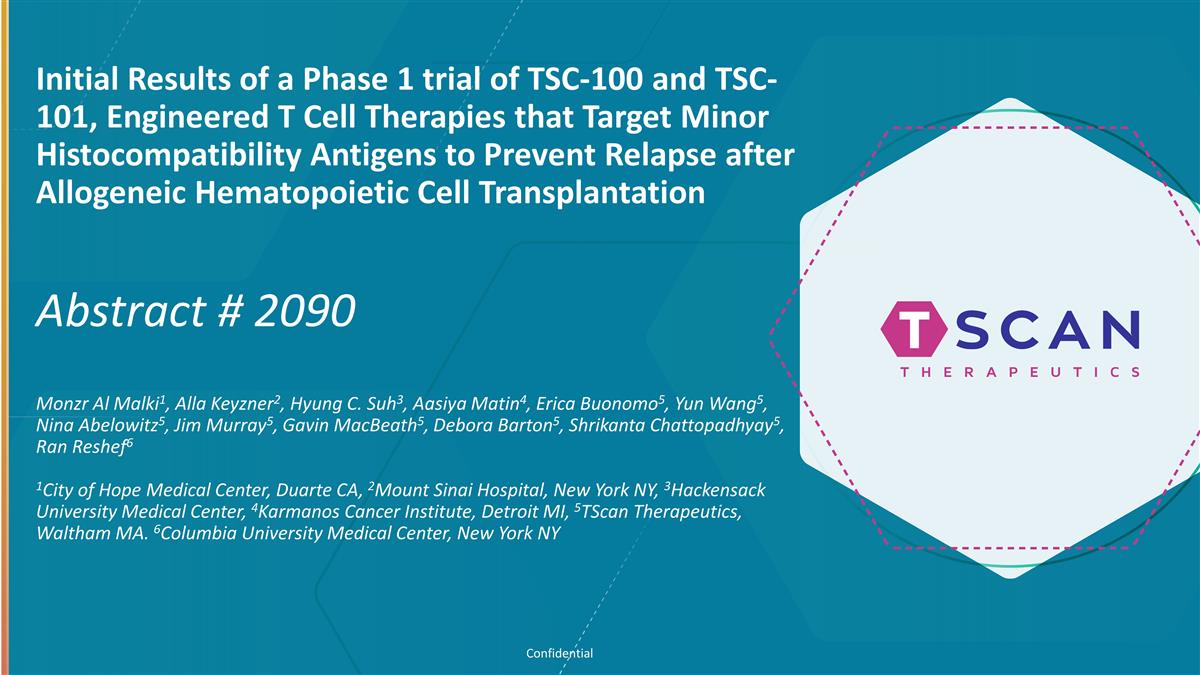
Initial Results of a Phase 1 trial
of TSC-100 and TSC-101, Engineered T Cell Therapies that Target Minor Histocompatibility Antigens to Prevent Relapse after Allogeneic Hematopoietic Cell Transplantation Abstract # 2090 Monzr Al Malki1, Alla Keyzner2, Hyung C. Suh3, Aasiya Matin4,
Erica Buonomo5, Yun Wang5, Nina Abelowitz5, Jim Murray5, Gavin MacBeath5, Debora Barton5, Shrikanta Chattopadhyay5, Ran Reshef6 1City of Hope Medical Center, Duarte CA, 2Mount Sinai Hospital, New York NY, 3Hackensack University Medical Center,
4Karmanos Cancer Institute, Detroit MI, 5TScan Therapeutics, Waltham MA. 6Columbia University Medical Center, New York NY Confidential
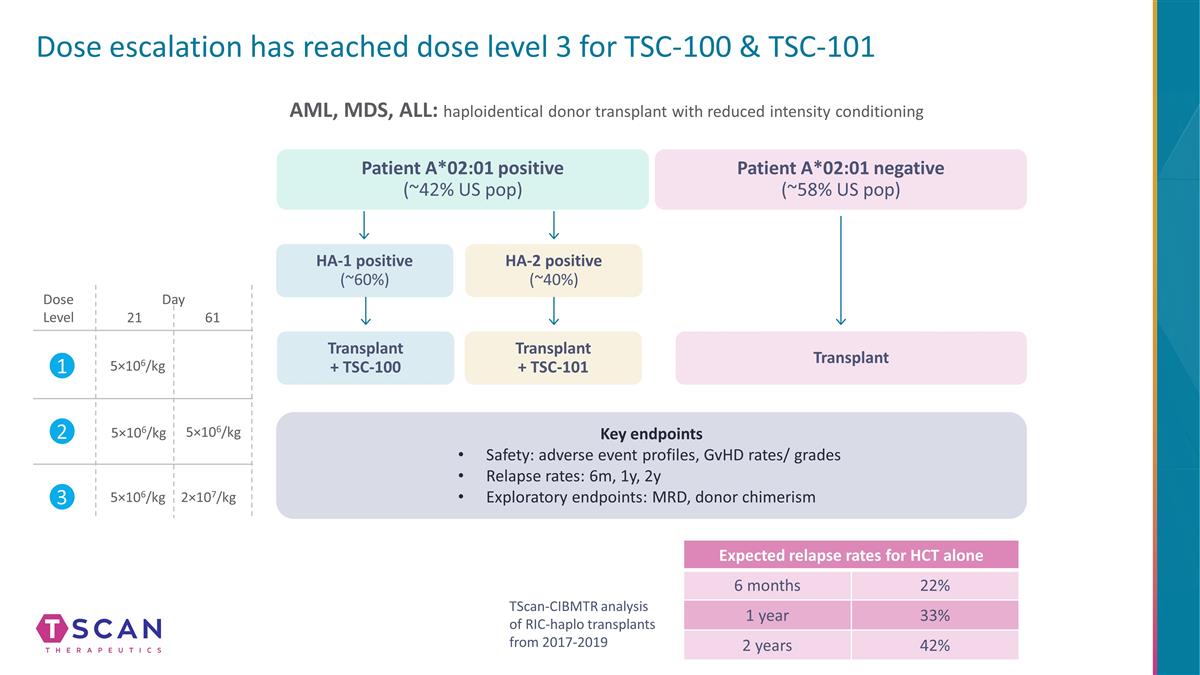
HA-2 positive (~40%) Transplant +
TSC-101 HA-1 positive (~60%) Patient A*02:01 negative (~58% US pop) Transplant Transplant + TSC-100 Dose escalation has reached dose level 3 for TSC-100 & TSC-101 Patient A*02:01 positive (~42% US pop) AML, MDS, ALL: haploidentical donor
transplant with reduced intensity conditioning Transplant + TSC-101 TScan-CIBMTR analysis of RIC-haplo transplants from 2017-2019 Dose Level 2 61 21 3 1 Day 5×106/kg 5×106/kg 5×106/kg 5×106/kg 2×107/kg Key endpoints Safety:
adverse event profiles, GvHD rates/ grades Relapse rates: 6m, 1y, 2y Exploratory endpoints: MRD, donor chimerism Expected relapse rates for HCT alone 6 months 22% 1 year 33% 2 years 42%
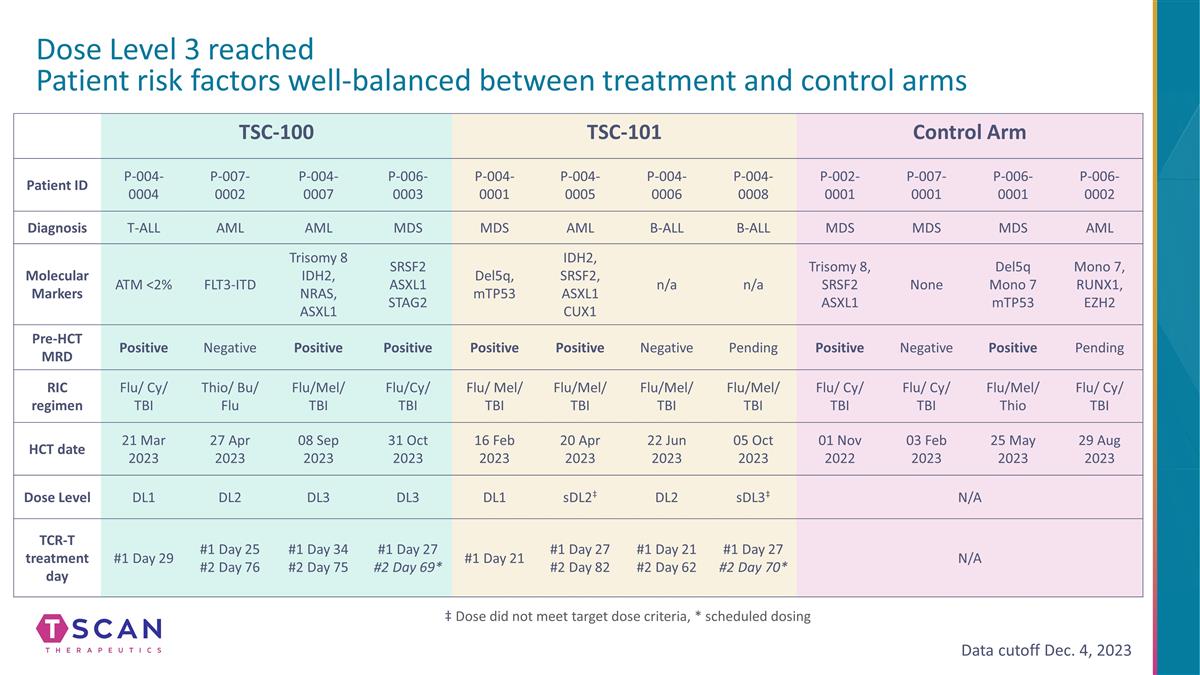
Dose Level 3 reached Patient risk
factors well-balanced between treatment and control arms ‡ Dose did not meet target dose criteria, * scheduled dosing TSC-100 TSC-101 Control Arm Patient ID P-004-0004 P-007-0002 P-004- 0007 P-006- 0003 P-004-0001 P-004-0005 P-004-0006
P-004-0008 P-002-0001 P-007-0001 P-006-0001 P-006-0002 Diagnosis T-ALL AML AML MDS MDS AML B-ALL B-ALL MDS MDS MDS AML Molecular Markers ATM <2% FLT3-ITD Trisomy 8 IDH2, NRAS, ASXL1 SRSF2 ASXL1 STAG2 Del5q, mTP53 IDH2, SRSF2, ASXL1 CUX1 n/a n/a
Trisomy 8, SRSF2 ASXL1 None Del5q Mono 7 mTP53 Mono 7, RUNX1, EZH2 Pre-HCT MRD Positive Negative Positive Positive Positive Positive Negative Pending Positive Negative Positive Pending RIC regimen Flu/ Cy/ TBI Thio/ Bu/ Flu Flu/Mel/ TBI Flu/Cy/ TBI
Flu/ Mel/ TBI Flu/Mel/ TBI Flu/Mel/ TBI Flu/Mel/ TBI Flu/ Cy/ TBI Flu/ Cy/ TBI Flu/Mel/ Thio Flu/ Cy/ TBI HCT date 21 Mar 2023 27 Apr 2023 08 Sep 2023 31 Oct 2023 16 Feb 2023 20 Apr 2023 22 Jun 2023 05 Oct 2023 01 Nov 2022 03 Feb 2023 25 May 2023 29
Aug 2023 Dose Level DL1 DL2 DL3 DL3 DL1 sDL2‡ DL2 sDL3‡ N/A N/A N/A N/A TCR-T treatment day #1 Day 29 #1 Day 25 #2 Day 76 #1 Day 34 #2 Day 75 #1 Day 27 #2 Day 69* #1 Day 21 #1 Day 27 #2 Day 82 #1 Day 21 #2 Day 62 #1 Day 27 #2 Day 70* N/A
N/A N/A N/A Data cutoff Dec. 4, 2023
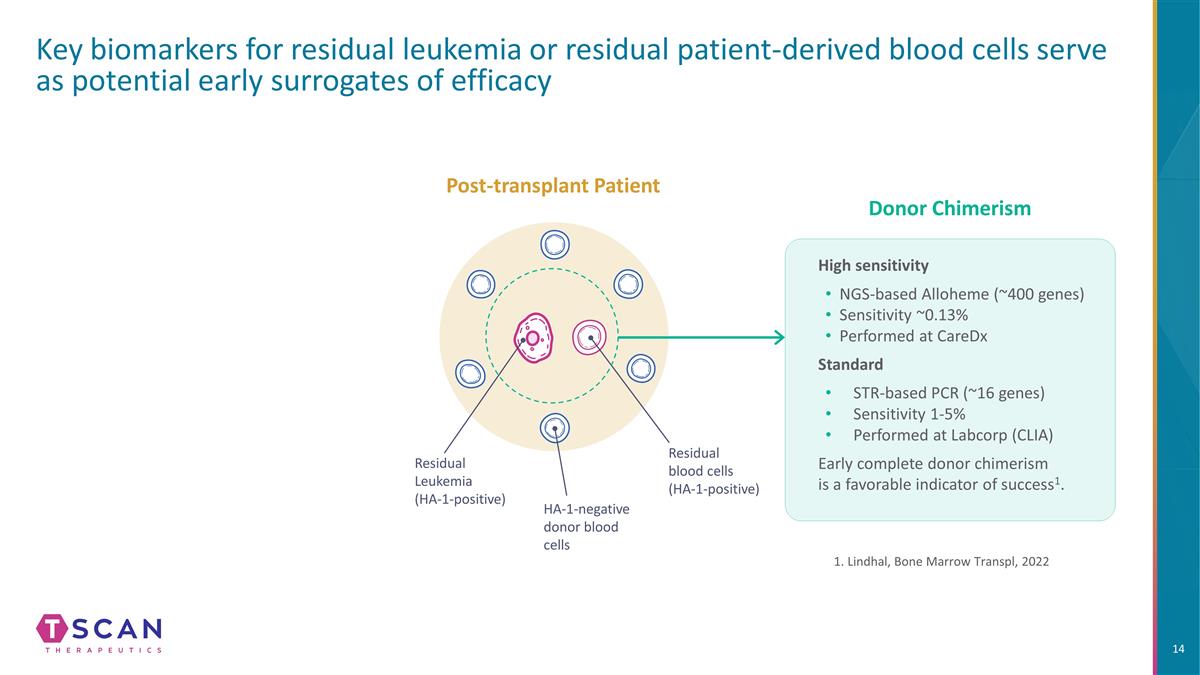
Key biomarkers for residual
leukemia or residual patient-derived blood cells serve as potential early surrogates of efficacy Residual Leukemia (HA-1-positive) Residual blood cells (HA-1-positive) High sensitivity NGS-based Alloheme (~400 genes) Sensitivity ~0.13% Performed at
CareDx Standard STR-based PCR (~16 genes) Sensitivity 1-5% Performed at Labcorp (CLIA) Early complete donor chimerism is a favorable indicator of success1. HA-1-negative donor blood cells Post-transplant Patient Donor Chimerism 1. Lindhal, Bone
Marrow Transpl, 2022
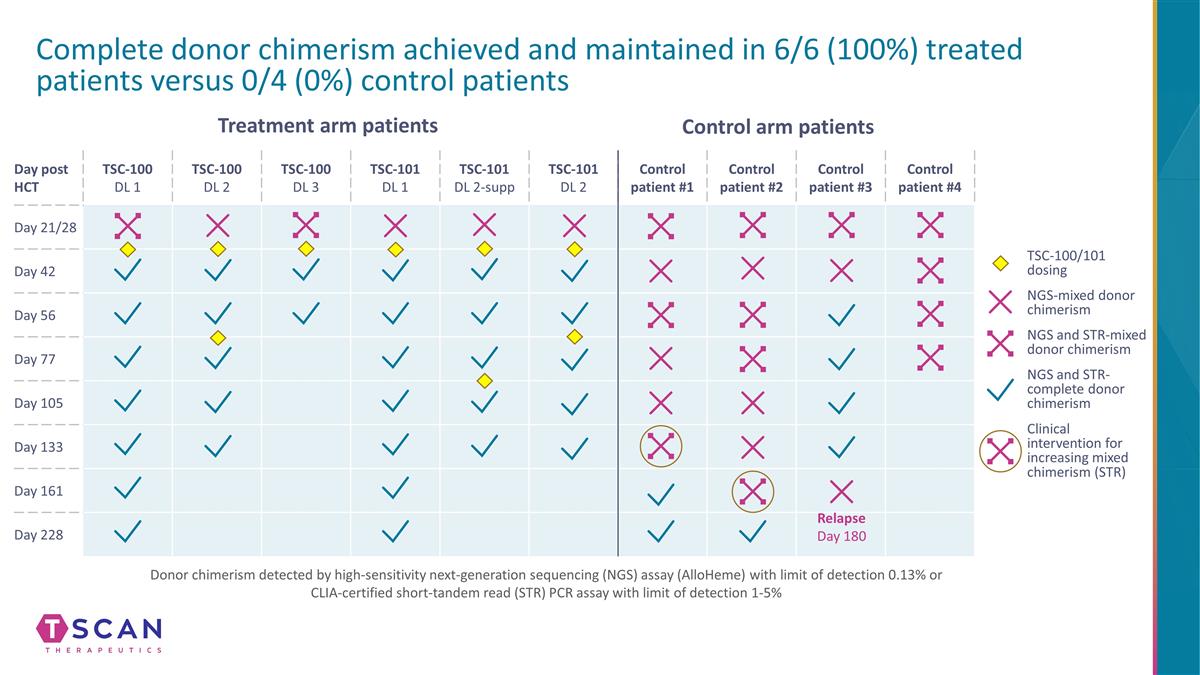
Control patient #1 Control patient
#2 Control patient #3 Control patient #4 Complete donor chimerism achieved and maintained in 6/6 (100%) treated patients versus 0/4 (0%) control patients Day post HCT TSC-100 DL 1 TSC-100 DL 2 TSC-100 DL 3 TSC-101 DL 1 TSC-101 DL 2-supp TSC-101 DL 2
Day 21/28 Day 42 Day 56 Day 77 Day 105 Day 133 Day 161 Day 228 NGS and STR- complete donor chimerism NGS-mixed donor chimerism Clinical intervention for increasing mixed chimerism (STR) TSC-100/101 dosing Control arm patients Treatment arm patients
NGS and STR-mixed donor chimerism Relapse Day 180 Donor chimerism detected by high-sensitivity next-generation sequencing (NGS) assay (AlloHeme) with limit of detection 0.13% or CLIA-certified short-tandem read (STR) PCR assay with limit of
detection 1-5%
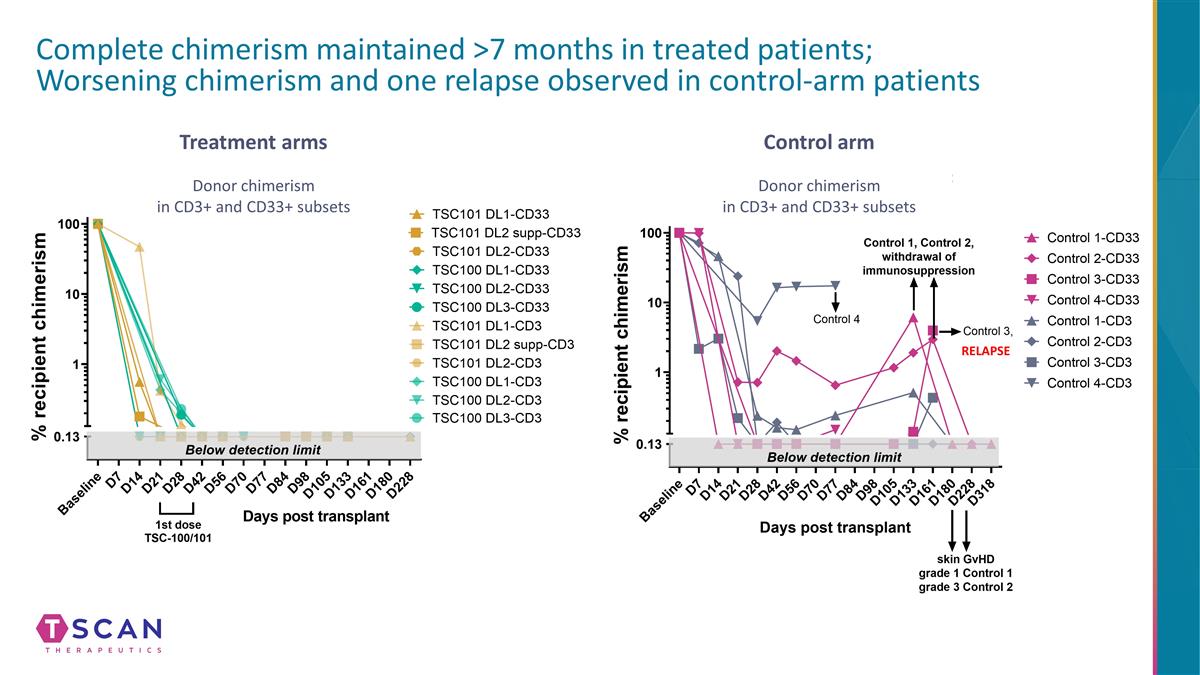
Complete chimerism maintained >7
months in treated patients; Worsening chimerism and one relapse observed in control-arm patients RELAPSE Donor chimerism in CD3+ and CD33+ subsets Treatment arms Donor chimerism in CD3+ and CD33+ subsets Control arm
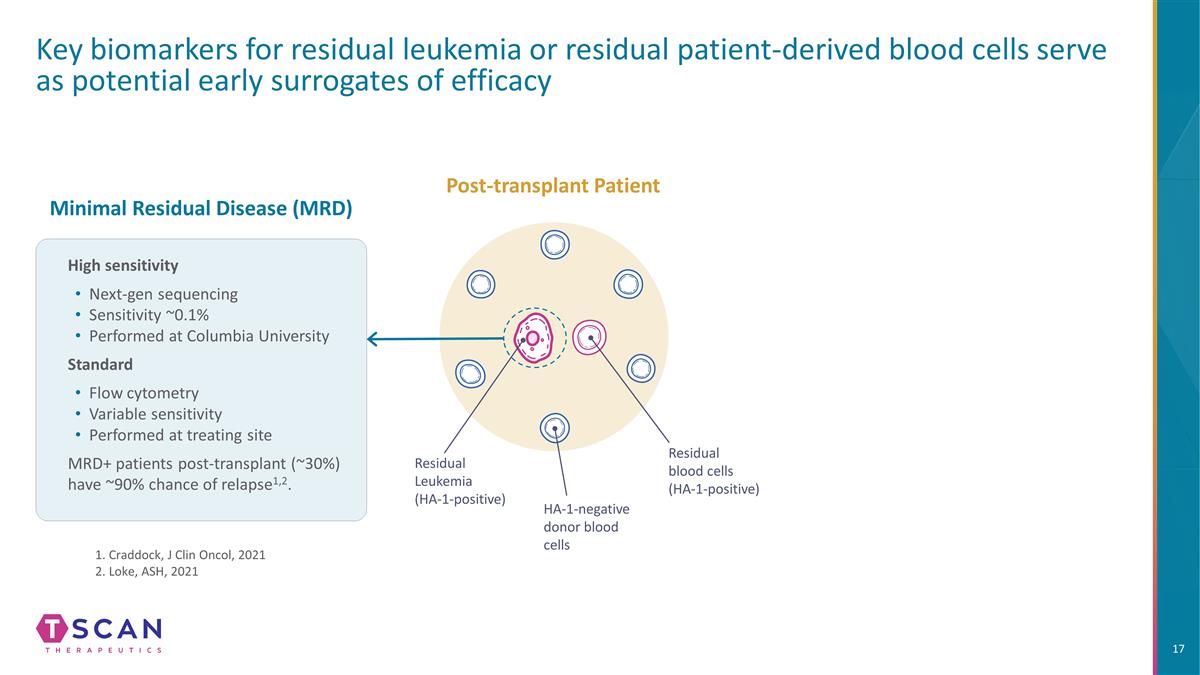
Key biomarkers for residual
leukemia or residual patient-derived blood cells serve as potential early surrogates of efficacy Residual Leukemia (HA-1-positive) Residual blood cells (HA-1-positive) High sensitivity Next-gen sequencing Sensitivity ~0.1% Performed at Columbia
University Standard Flow cytometry Variable sensitivity Performed at treating site MRD+ patients post-transplant (~30%) have ~90% chance of relapse1,2. HA-1-negative donor blood cells Post-transplant Patient 1. Craddock, J Clin Oncol, 2021 2. Loke,
ASH, 2021 Minimal Residual Disease (MRD)
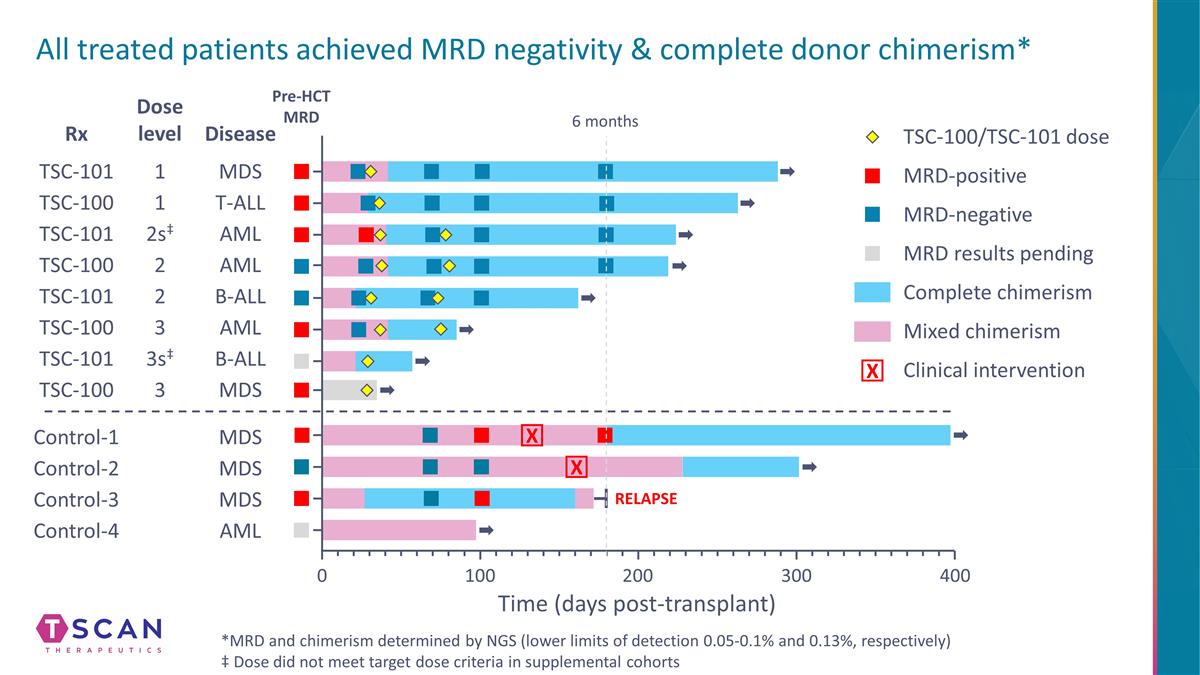
All treated patients achieved MRD
negativity & complete donor chimerism* *MRD and chimerism determined by NGS (lower limits of detection 0.05-0.1% and 0.13%, respectively) ‡ Dose did not meet target dose criteria in supplemental cohorts X X 0 100 200 300 400 MDS T-ALL AML
AML B-ALL AML B-ALL MDS MDS MDS MDS AML TSC-101 TSC-100 TSC-101 TSC-100 TSC-101 TSC-100 TSC-101 TSC-100 Control-1 Control-2 Control-3 Control-4 Disease Rx Dose level 1 1 2s‡ 2 2 3 3s‡ 3 Time (days post-transplant) Pre-HCT MRD RELAPSE X
MRD-positive TSC-100/TSC-101 dose MRD-negative MRD results pending Complete chimerism Mixed chimerism Clinical intervention 6 months
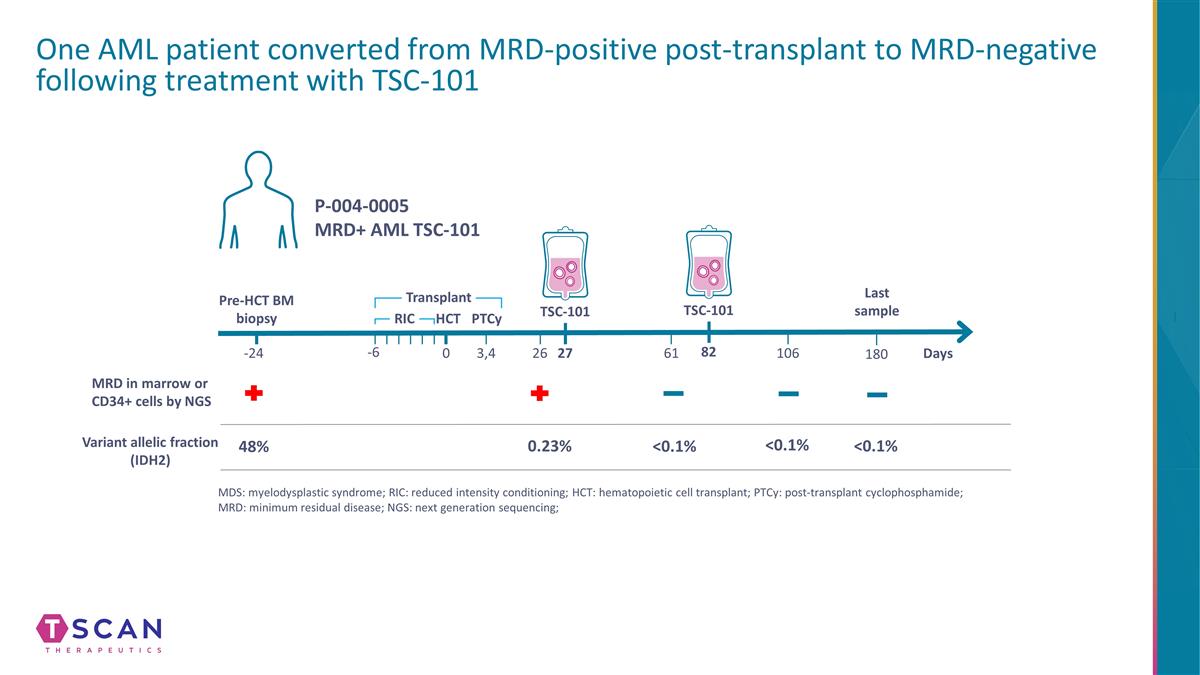
One AML patient converted from
MRD-positive post-transplant to MRD-negative following treatment with TSC-101 P-004-0005 MRD+ AML TSC-101 Days MDS: myelodysplastic syndrome; RIC: reduced intensity conditioning; HCT: hematopoietic cell transplant; PTCy: post-transplant
cyclophosphamide; MRD: minimum residual disease; NGS: next generation sequencing; TSC-101 0 -24 3,4 27 26 61 106 Pre-HCT BM biopsy Last sample HCT PTCy -6 RIC Transplant MRD in marrow or CD34+ cells by NGS Variant allelic fraction (IDH2) 48% 0.23%
<0.1% <0.1% 180 <0.1% TSC-101 82
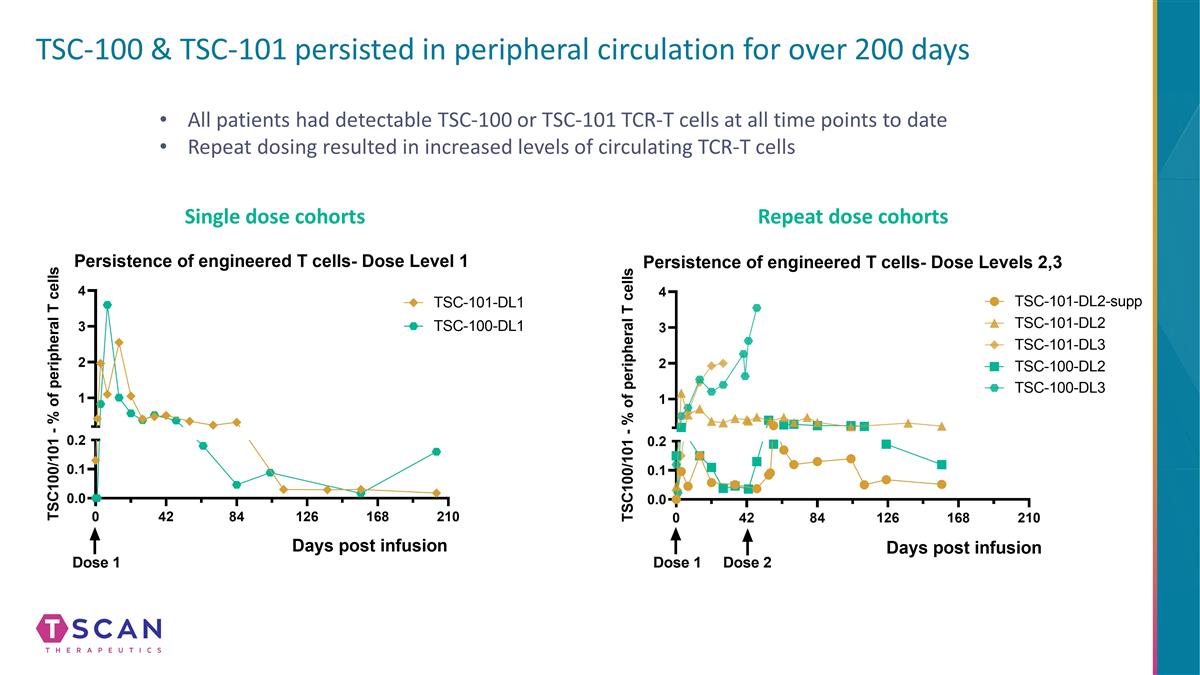
TSC-100 & TSC-101 persisted in
peripheral circulation for over 200 days Single dose cohorts Repeat dose cohorts All patients had detectable TSC-100 or TSC-101 TCR-T cells at all time points to date Repeat dosing resulted in increased levels of circulating TCR-T cells
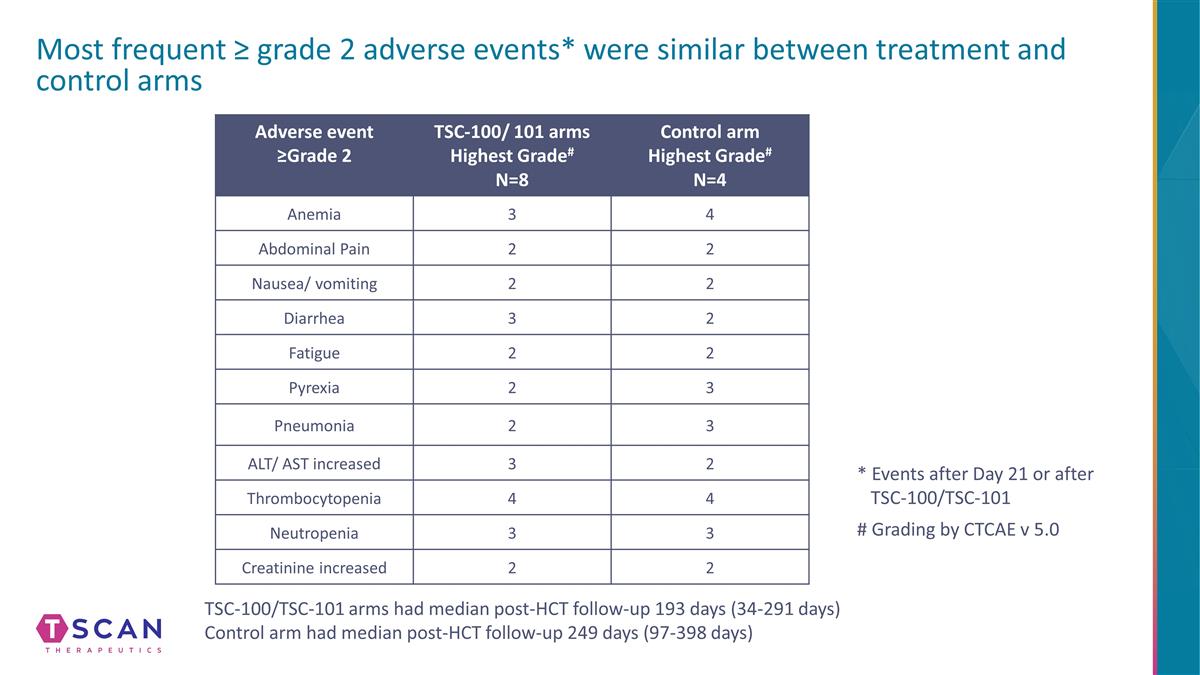
Most frequent ≥ grade 2
adverse events* were similar between treatment and control arms Adverse event ≥Grade 2 TSC-100/ 101 arms Highest Grade# N=8 Control arm Highest Grade# N=4 Anemia 3 4 Abdominal Pain 2 2 Nausea/ vomiting 2 2 Diarrhea 3 2 Fatigue 2 2 Pyrexia 2 3
Pneumonia 2 3 ALT/ AST increased 3 2 Thrombocytopenia 4 4 Neutropenia 3 3 Creatinine increased 2 2 TSC-100/TSC-101 arms had median post-HCT follow-up 193 days (34-291 days) Control arm had median post-HCT follow-up 249 days (97-398 days) * Events
after Day 21 or after TSC-100/TSC-101 # Grading by CTCAE v 5.0
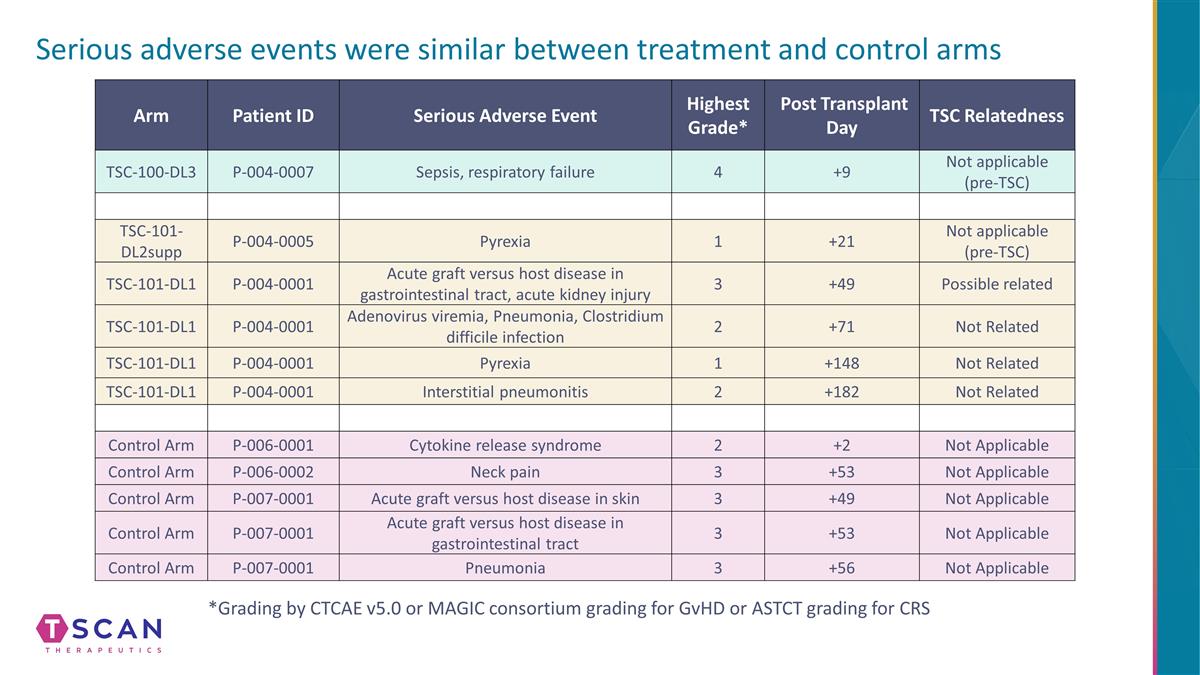
Serious adverse events were similar
between treatment and control arms Arm Patient ID Serious Adverse Event Highest Grade* Post Transplant Day TSC Relatedness TSC-100-DL3 P-004-0007 Sepsis, respiratory failure 4 +9 Not applicable (pre-TSC) TSC-101-DL2supp P-004-0005 Pyrexia 1 +21 Not
applicable (pre-TSC) TSC-101-DL1 P-004-0001 Acute graft versus host disease in gastrointestinal tract, acute kidney injury 3 +49 Possible related TSC-101-DL1 P-004-0001 Adenovirus viremia, Pneumonia, Clostridium difficile infection 2 +71 Not Related
TSC-101-DL1 P-004-0001 Pyrexia 1 +148 Not Related TSC-101-DL1 P-004-0001 Interstitial pneumonitis 2 +182 Not Related Control Arm P-006-0001 Cytokine release syndrome 2 +2 Not Applicable Control Arm P-006-0002 Neck pain 3 +53 Not Applicable Control
Arm P-007-0001 Acute graft versus host disease in skin 3 +49 Not Applicable Control Arm P-007-0001 Acute graft versus host disease in gastrointestinal tract 3 +53 Not Applicable Control Arm P-007-0001 Pneumonia 3 +56 Not Applicable *Grading by CTCAE
v5.0 or MAGIC consortium grading for GvHD or ASTCT grading for CRS
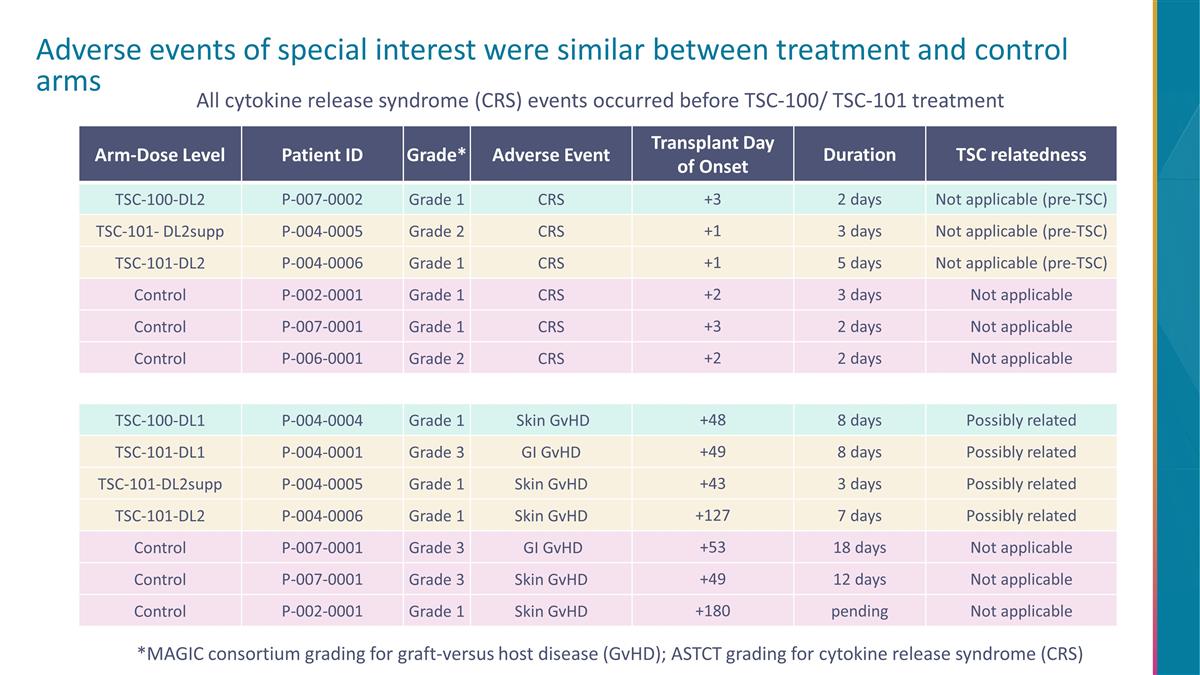
Adverse events of special interest
were similar between treatment and control arms Arm-Dose Level Patient ID Grade* Adverse Event Transplant Day of Onset Duration TSC relatedness TSC-100-DL2 P-007-0002 Grade 1 CRS +3 2 days Not applicable (pre-TSC) TSC-101- DL2supp P-004-0005 Grade 2
CRS +1 3 days Not applicable (pre-TSC) TSC-101-DL2 P-004-0006 Grade 1 CRS +1 5 days Not applicable (pre-TSC) Control P-002-0001 Grade 1 CRS +2 3 days Not applicable Control P-007-0001 Grade 1 CRS +3 2 days Not applicable Control P-006-0001 Grade 2
CRS +2 2 days Not applicable TSC-100-DL1 P-004-0004 Grade 1 Skin GvHD +48 8 days Possibly related TSC-101-DL1 P-004-0001 Grade 3 GI GvHD +49 8 days Possibly related TSC-101-DL2supp P-004-0005 Grade 1 Skin GvHD +43 3 days Possibly related TSC-101-DL2
P-004-0006 Grade 1 Skin GvHD +127 7 days Possibly related Control P-007-0001 Grade 3 GI GvHD +53 18 days Not applicable Control P-007-0001 Grade 3 Skin GvHD +49 12 days Not applicable Control P-002-0001 Grade 1 Skin GvHD +180 pending Not applicable
*MAGIC consortium grading for graft-versus host disease (GvHD); ASTCT grading for cytokine release syndrome (CRS) All cytokine release syndrome (CRS) events occurred before TSC-100/ TSC-101 treatment
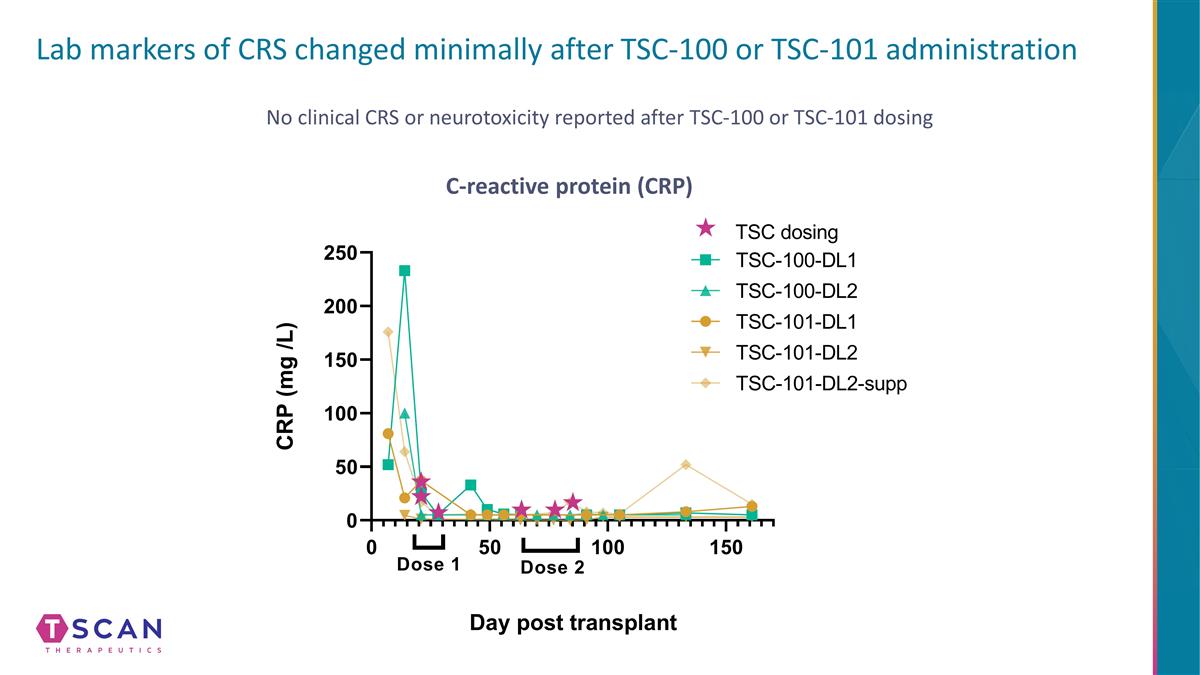
Lab markers of CRS changed
minimally after TSC-100 or TSC-101 administration No clinical CRS or neurotoxicity reported after TSC-100 or TSC-101 dosing C-reactive protein (CRP)
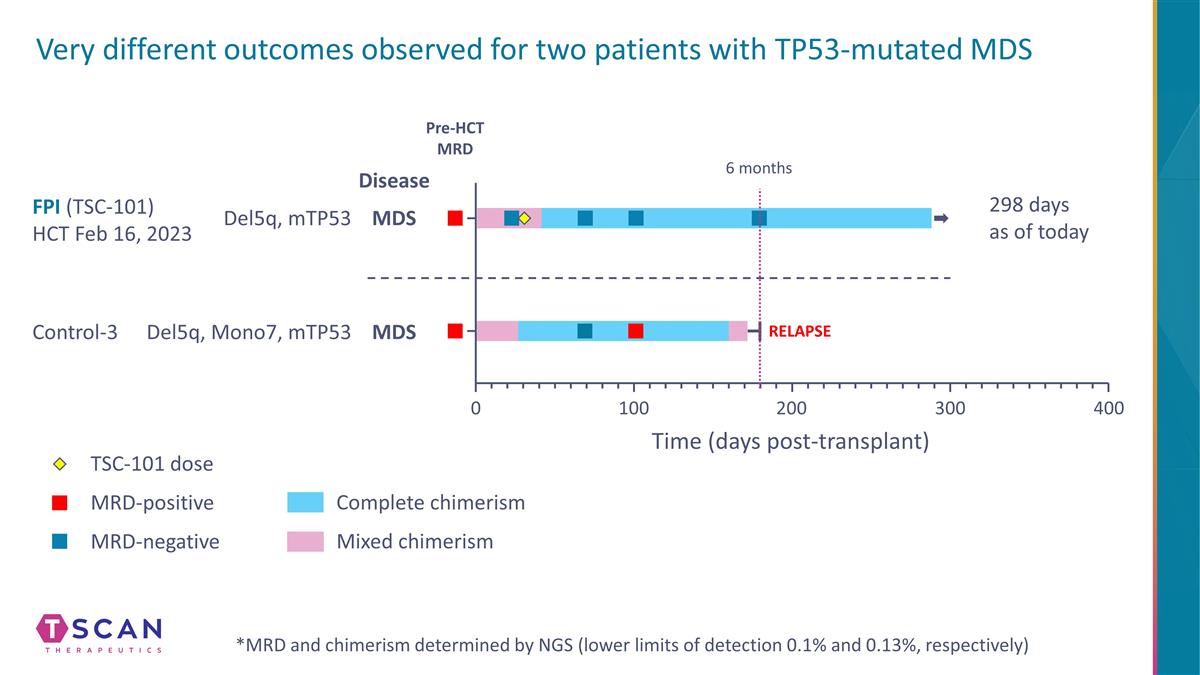
Very different outcomes observed
for two patients with TP53-mutated MDS *MRD and chimerism determined by NGS (lower limits of detection 0.1% and 0.13%, respectively) 0 100 200 300 400 MDS MDS Control-3 Disease Time (days post-transplant) Pre-HCT MRD RELAPSE MRD-positive TSC-101
dose MRD-negative Complete chimerism Mixed chimerism 6 months Del5q, mTP53 FPI (TSC-101) HCT Feb 16, 2023 Del5q, Mono7, mTP53 298 days as of today
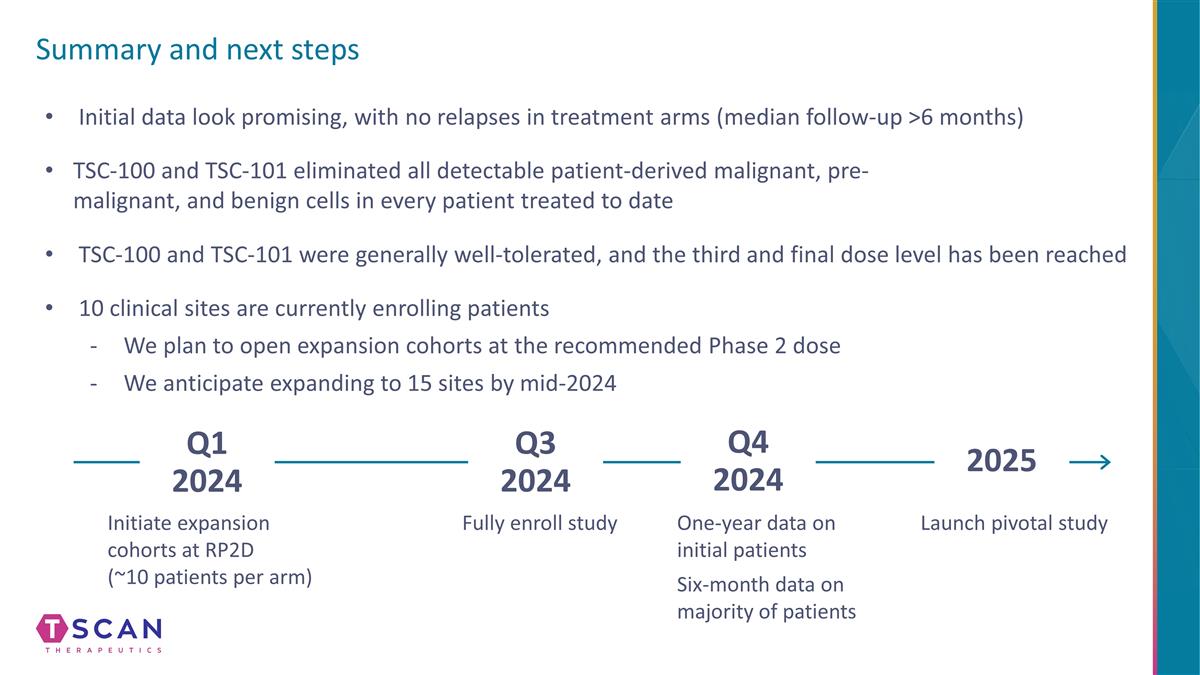
Summary and next steps Initial data
look promising, with no relapses in treatment arms (median follow-up >6 months) TSC-100 and TSC-101 were generally well-tolerated, and the third and final dose level has been reached 10 clinical sites are currently enrolling patients We plan to
open expansion cohorts at the recommended Phase 2 dose We anticipate expanding to 15 sites by mid-2024 Q1 2024 Q3 2024 Q4 2024 2025 Initiate expansion cohorts at RP2D (~10 patients per arm) Fully enroll study One-year data on initial patients
Six-month data on majority of patients Launch pivotal study TSC-100 and TSC-101 eliminated all detectable patient-derived malignant, pre-malignant, and benign cells in every patient treated to date
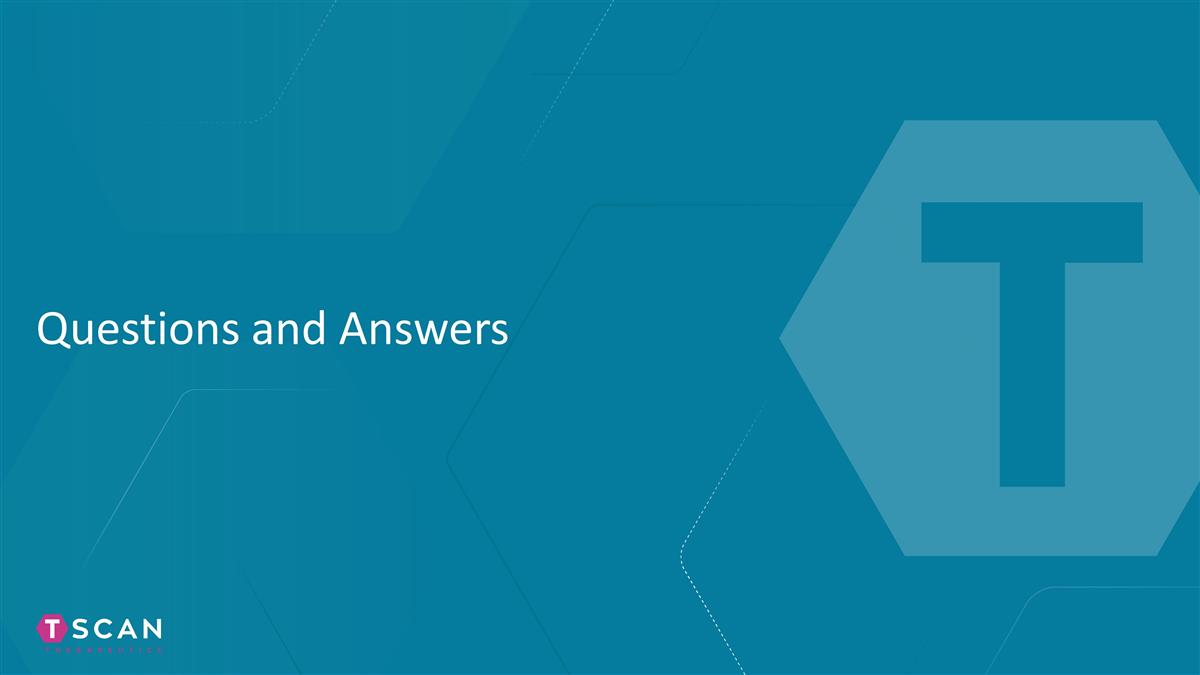
Questions and Answers
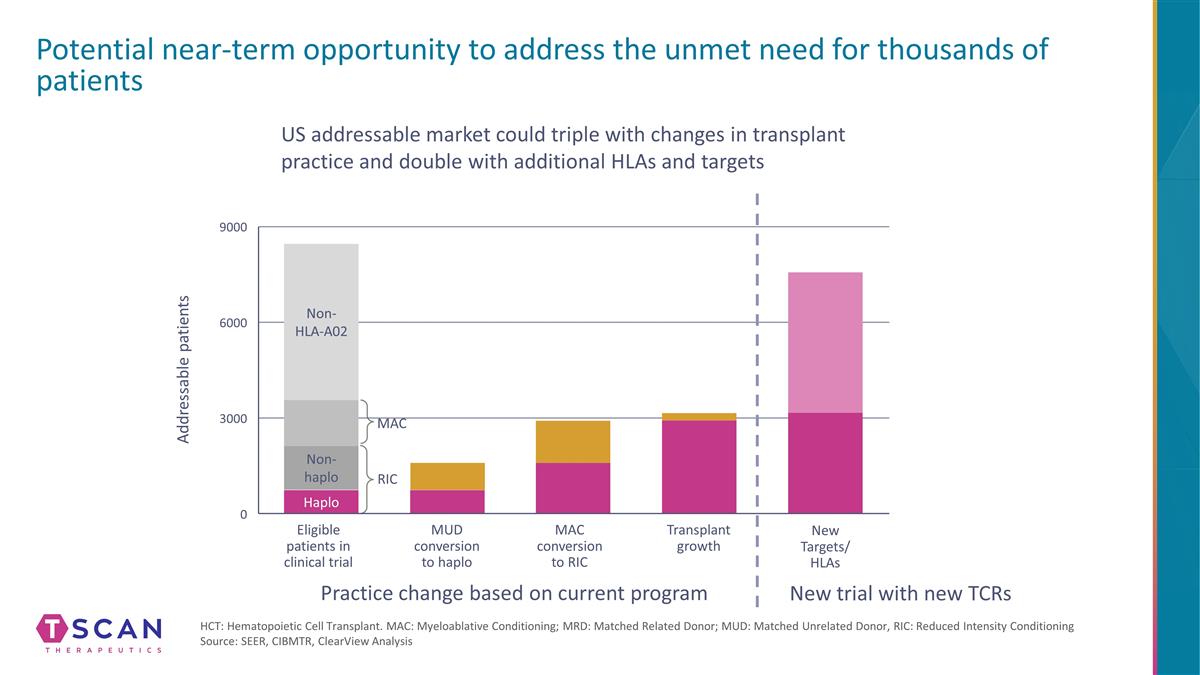
Potential near-term opportunity to
address the unmet need for thousands of patients Non-HLA A02 Non-Haplo US addressable market could triple with changes in transplant practice and double with additional HLAs and targets HCT: Hematopoietic Cell Transplant. MAC: Myeloablative
Conditioning; MRD: Matched Related Donor; MUD: Matched Unrelated Donor, RIC: Reduced Intensity Conditioning Source: SEER, CIBMTR, ClearView Analysis MAC RIC Haplo 0 9000 6000 3000 Addressable patients Haplo Non-haplo Non-HLA-A02 Eligible patients in
clinical trial MUD conversion to haplo Transplant growth MAC conversion to RIC New Targets/ HLAs Practice change based on current program New trial with new TCRs
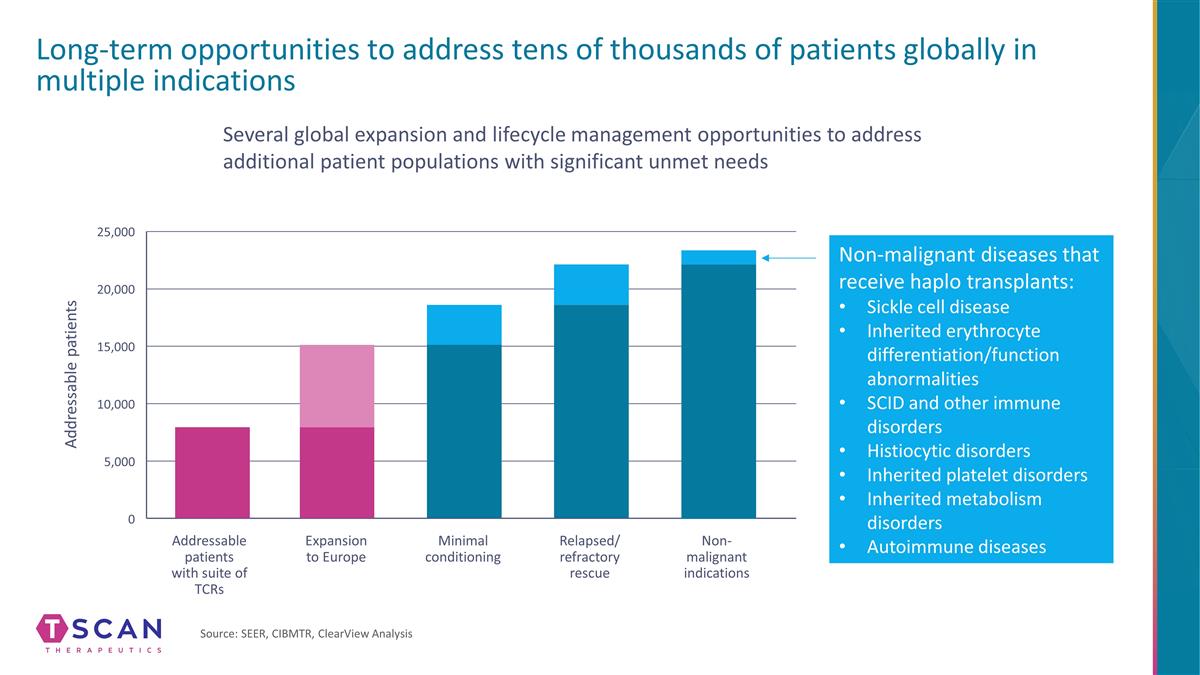
Long-term opportunities to address
tens of thousands of patients globally in multiple indications Addressable patients with suite of TCRs Expansion to Europe Minimal conditioning Relapsed/ refractory rescue Non-malignant indications Source: SEER, CIBMTR, ClearView Analysis 0 25,000
20,000 15,000 Addressable patients 10,000 5,000 Several global expansion and lifecycle management opportunities to address additional patient populations with significant unmet needs Non-malignant diseases that receive haplo transplants: Sickle cell
disease Inherited erythrocyte differentiation/function abnormalities SCID and other immune disorders Histiocytic disorders Inherited platelet disorders Inherited metabolism disorders Autoimmune diseases
v3.23.3
| X |
- DefinitionBoolean flag that is true when the XBRL content amends previously-filed or accepted submission.
| Name: |
dei_AmendmentFlag |
| Namespace Prefix: |
dei_ |
| Data Type: |
xbrli:booleanItemType |
| Balance Type: |
na |
| Period Type: |
duration |
|
| X |
- DefinitionFor the EDGAR submission types of Form 8-K: the date of the report, the date of the earliest event reported; for the EDGAR submission types of Form N-1A: the filing date; for all other submission types: the end of the reporting or transition period. The format of the date is YYYY-MM-DD.
| Name: |
dei_DocumentPeriodEndDate |
| Namespace Prefix: |
dei_ |
| Data Type: |
xbrli:dateItemType |
| Balance Type: |
na |
| Period Type: |
duration |
|
| X |
- DefinitionThe type of document being provided (such as 10-K, 10-Q, 485BPOS, etc). The document type is limited to the same value as the supporting SEC submission type, or the word 'Other'.
| Name: |
dei_DocumentType |
| Namespace Prefix: |
dei_ |
| Data Type: |
dei:submissionTypeItemType |
| Balance Type: |
na |
| Period Type: |
duration |
|
| X |
- DefinitionAddress Line 1 such as Attn, Building Name, Street Name
| Name: |
dei_EntityAddressAddressLine1 |
| Namespace Prefix: |
dei_ |
| Data Type: |
xbrli:normalizedStringItemType |
| Balance Type: |
na |
| Period Type: |
duration |
|
| X |
- Definition
+ References
+ Details
| Name: |
dei_EntityAddressCityOrTown |
| Namespace Prefix: |
dei_ |
| Data Type: |
xbrli:normalizedStringItemType |
| Balance Type: |
na |
| Period Type: |
duration |
|
| X |
- DefinitionCode for the postal or zip code
| Name: |
dei_EntityAddressPostalZipCode |
| Namespace Prefix: |
dei_ |
| Data Type: |
xbrli:normalizedStringItemType |
| Balance Type: |
na |
| Period Type: |
duration |
|
| X |
- DefinitionName of the state or province.
| Name: |
dei_EntityAddressStateOrProvince |
| Namespace Prefix: |
dei_ |
| Data Type: |
dei:stateOrProvinceItemType |
| Balance Type: |
na |
| Period Type: |
duration |
|
| X |
- DefinitionA unique 10-digit SEC-issued value to identify entities that have filed disclosures with the SEC. It is commonly abbreviated as CIK. Reference 1: http://www.xbrl.org/2003/role/presentationRef
-Publisher SEC
-Name Exchange Act
-Number 240
-Section 12
-Subsection b-2
| Name: |
dei_EntityCentralIndexKey |
| Namespace Prefix: |
dei_ |
| Data Type: |
dei:centralIndexKeyItemType |
| Balance Type: |
na |
| Period Type: |
duration |
|
| X |
- DefinitionIndicate if registrant meets the emerging growth company criteria. Reference 1: http://www.xbrl.org/2003/role/presentationRef
-Publisher SEC
-Name Exchange Act
-Number 240
-Section 12
-Subsection b-2
| Name: |
dei_EntityEmergingGrowthCompany |
| Namespace Prefix: |
dei_ |
| Data Type: |
xbrli:booleanItemType |
| Balance Type: |
na |
| Period Type: |
duration |
|
| X |
- DefinitionCommission file number. The field allows up to 17 characters. The prefix may contain 1-3 digits, the sequence number may contain 1-8 digits, the optional suffix may contain 1-4 characters, and the fields are separated with a hyphen.
| Name: |
dei_EntityFileNumber |
| Namespace Prefix: |
dei_ |
| Data Type: |
dei:fileNumberItemType |
| Balance Type: |
na |
| Period Type: |
duration |
|
| X |
- DefinitionTwo-character EDGAR code representing the state or country of incorporation.
| Name: |
dei_EntityIncorporationStateCountryCode |
| Namespace Prefix: |
dei_ |
| Data Type: |
dei:edgarStateCountryItemType |
| Balance Type: |
na |
| Period Type: |
duration |
|
| X |
- DefinitionThe exact name of the entity filing the report as specified in its charter, which is required by forms filed with the SEC. Reference 1: http://www.xbrl.org/2003/role/presentationRef
-Publisher SEC
-Name Exchange Act
-Number 240
-Section 12
-Subsection b-2
| Name: |
dei_EntityRegistrantName |
| Namespace Prefix: |
dei_ |
| Data Type: |
xbrli:normalizedStringItemType |
| Balance Type: |
na |
| Period Type: |
duration |
|
| X |
- DefinitionThe Tax Identification Number (TIN), also known as an Employer Identification Number (EIN), is a unique 9-digit value assigned by the IRS. Reference 1: http://www.xbrl.org/2003/role/presentationRef
-Publisher SEC
-Name Exchange Act
-Number 240
-Section 12
-Subsection b-2
| Name: |
dei_EntityTaxIdentificationNumber |
| Namespace Prefix: |
dei_ |
| Data Type: |
dei:employerIdItemType |
| Balance Type: |
na |
| Period Type: |
duration |
|
| X |
- DefinitionLocal phone number for entity.
| Name: |
dei_LocalPhoneNumber |
| Namespace Prefix: |
dei_ |
| Data Type: |
xbrli:normalizedStringItemType |
| Balance Type: |
na |
| Period Type: |
duration |
|
| X |
- DefinitionBoolean flag that is true when the Form 8-K filing is intended to satisfy the filing obligation of the registrant as pre-commencement communications pursuant to Rule 13e-4(c) under the Exchange Act. Reference 1: http://www.xbrl.org/2003/role/presentationRef
-Publisher SEC
-Name Exchange Act
-Number 240
-Section 13e
-Subsection 4c
| Name: |
dei_PreCommencementIssuerTenderOffer |
| Namespace Prefix: |
dei_ |
| Data Type: |
xbrli:booleanItemType |
| Balance Type: |
na |
| Period Type: |
duration |
|
| X |
- DefinitionBoolean flag that is true when the Form 8-K filing is intended to satisfy the filing obligation of the registrant as pre-commencement communications pursuant to Rule 14d-2(b) under the Exchange Act. Reference 1: http://www.xbrl.org/2003/role/presentationRef
-Publisher SEC
-Name Exchange Act
-Number 240
-Section 14d
-Subsection 2b
| Name: |
dei_PreCommencementTenderOffer |
| Namespace Prefix: |
dei_ |
| Data Type: |
xbrli:booleanItemType |
| Balance Type: |
na |
| Period Type: |
duration |
|
| X |
- DefinitionTitle of a 12(b) registered security. Reference 1: http://www.xbrl.org/2003/role/presentationRef
-Publisher SEC
-Name Exchange Act
-Number 240
-Section 12
-Subsection b
| Name: |
dei_Security12bTitle |
| Namespace Prefix: |
dei_ |
| Data Type: |
dei:securityTitleItemType |
| Balance Type: |
na |
| Period Type: |
duration |
|
| X |
- DefinitionName of the Exchange on which a security is registered. Reference 1: http://www.xbrl.org/2003/role/presentationRef
-Publisher SEC
-Name Exchange Act
-Number 240
-Section 12
-Subsection d1-1
| Name: |
dei_SecurityExchangeName |
| Namespace Prefix: |
dei_ |
| Data Type: |
dei:edgarExchangeCodeItemType |
| Balance Type: |
na |
| Period Type: |
duration |
|
| X |
- DefinitionBoolean flag that is true when the Form 8-K filing is intended to satisfy the filing obligation of the registrant as soliciting material pursuant to Rule 14a-12 under the Exchange Act. Reference 1: http://www.xbrl.org/2003/role/presentationRef
-Publisher SEC
-Name Exchange Act
-Section 14a
-Number 240
-Subsection 12
| Name: |
dei_SolicitingMaterial |
| Namespace Prefix: |
dei_ |
| Data Type: |
xbrli:booleanItemType |
| Balance Type: |
na |
| Period Type: |
duration |
|
| X |
- DefinitionTrading symbol of an instrument as listed on an exchange.
| Name: |
dei_TradingSymbol |
| Namespace Prefix: |
dei_ |
| Data Type: |
dei:tradingSymbolItemType |
| Balance Type: |
na |
| Period Type: |
duration |
|
| X |
- DefinitionBoolean flag that is true when the Form 8-K filing is intended to satisfy the filing obligation of the registrant as written communications pursuant to Rule 425 under the Securities Act. Reference 1: http://www.xbrl.org/2003/role/presentationRef
-Publisher SEC
-Name Securities Act
-Number 230
-Section 425
| Name: |
dei_WrittenCommunications |
| Namespace Prefix: |
dei_ |
| Data Type: |
xbrli:booleanItemType |
| Balance Type: |
na |
| Period Type: |
duration |
|
TScan Therapeutics (NASDAQ:TCRX)
Historical Stock Chart
From Mar 2024 to Apr 2024

TScan Therapeutics (NASDAQ:TCRX)
Historical Stock Chart
From Apr 2023 to Apr 2024
